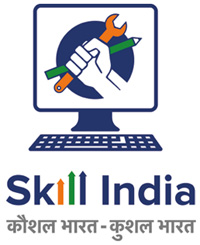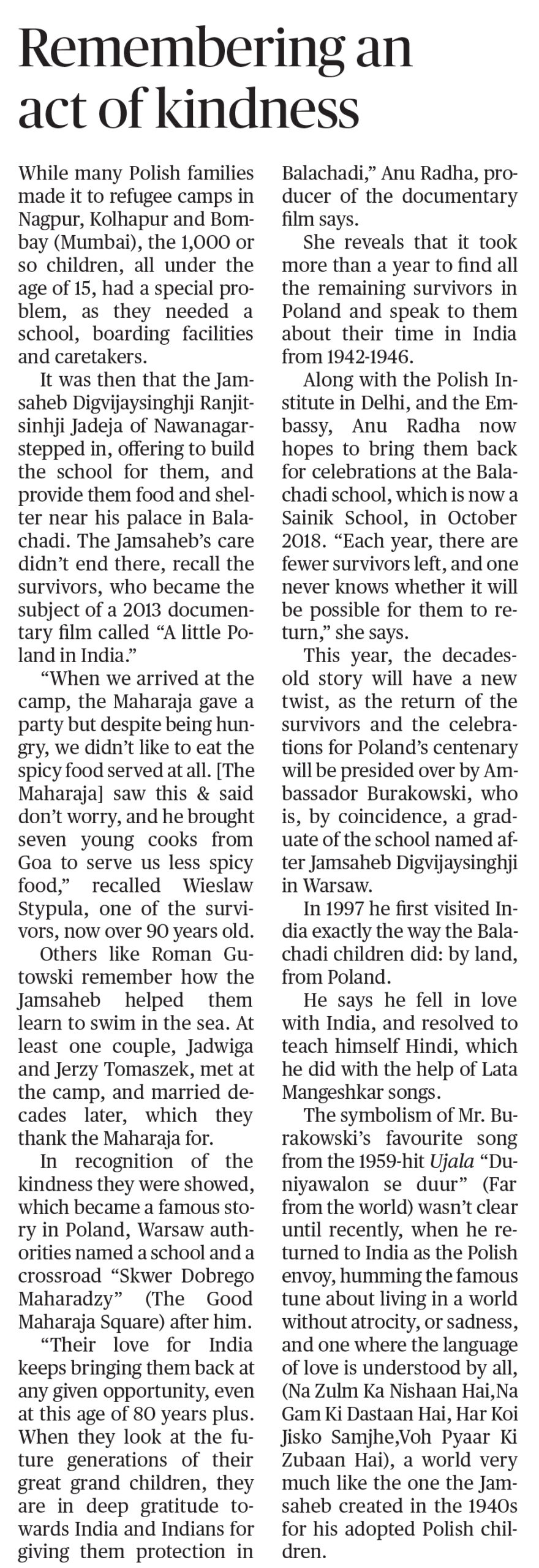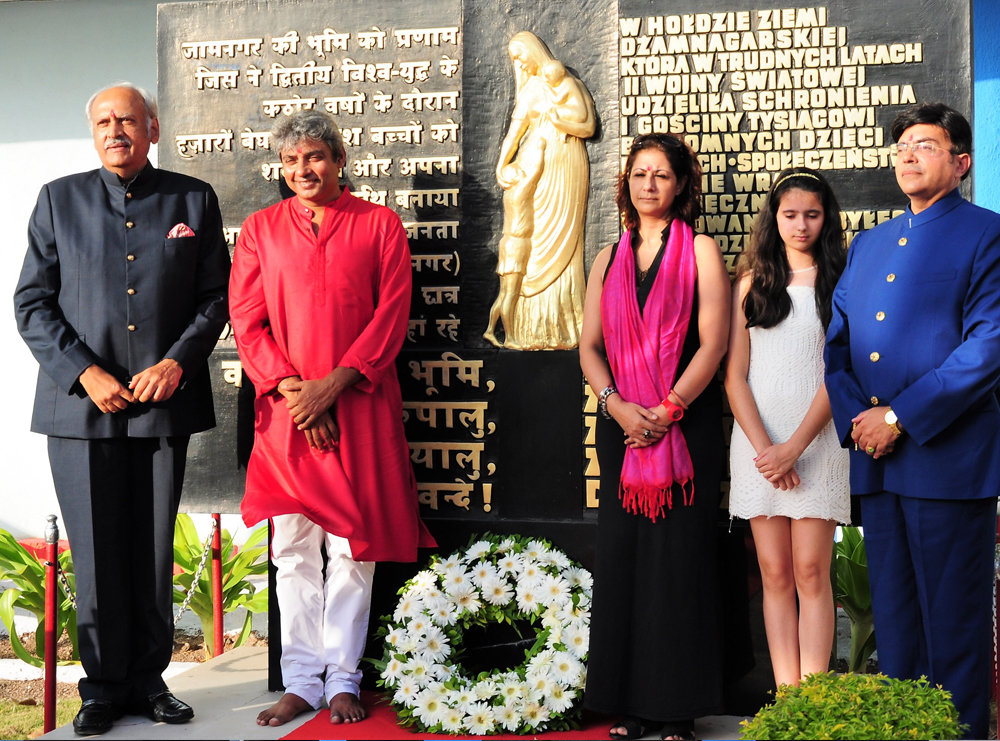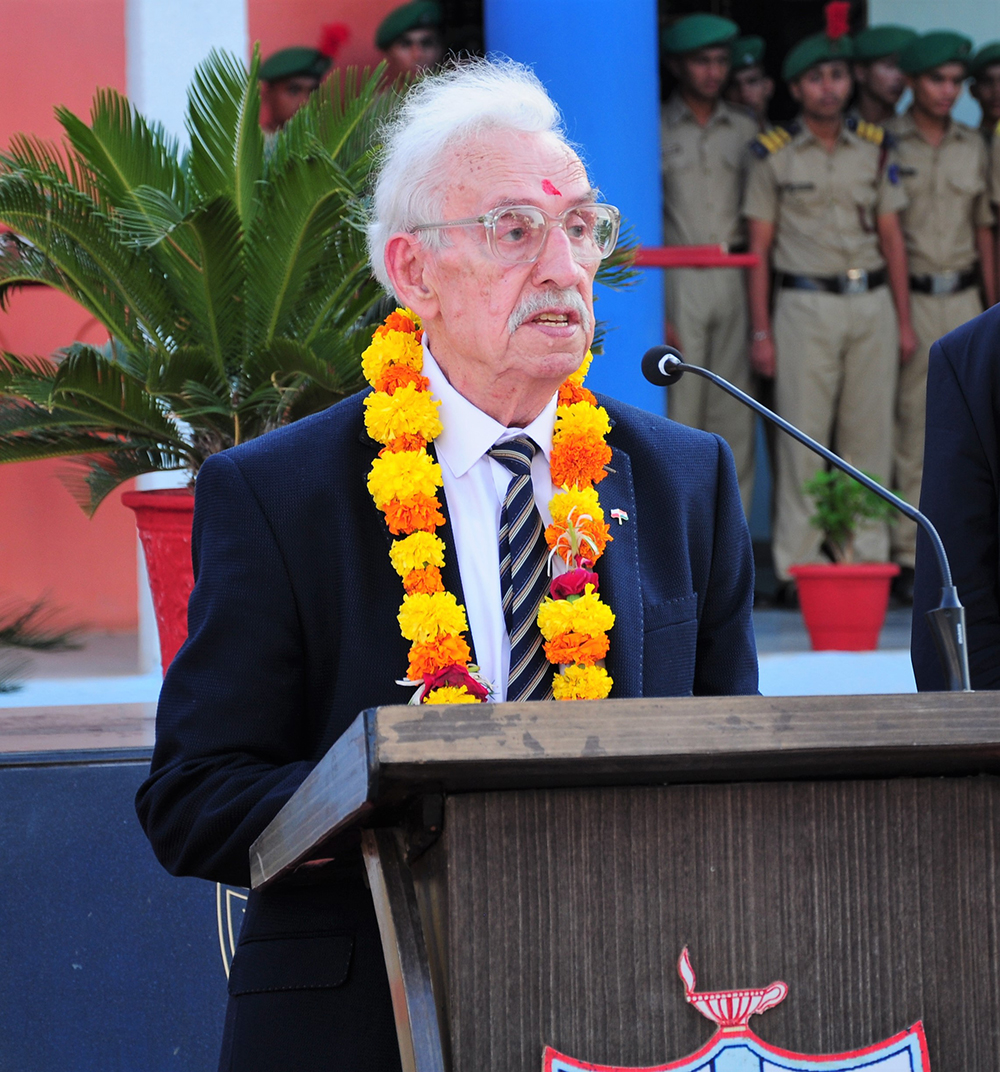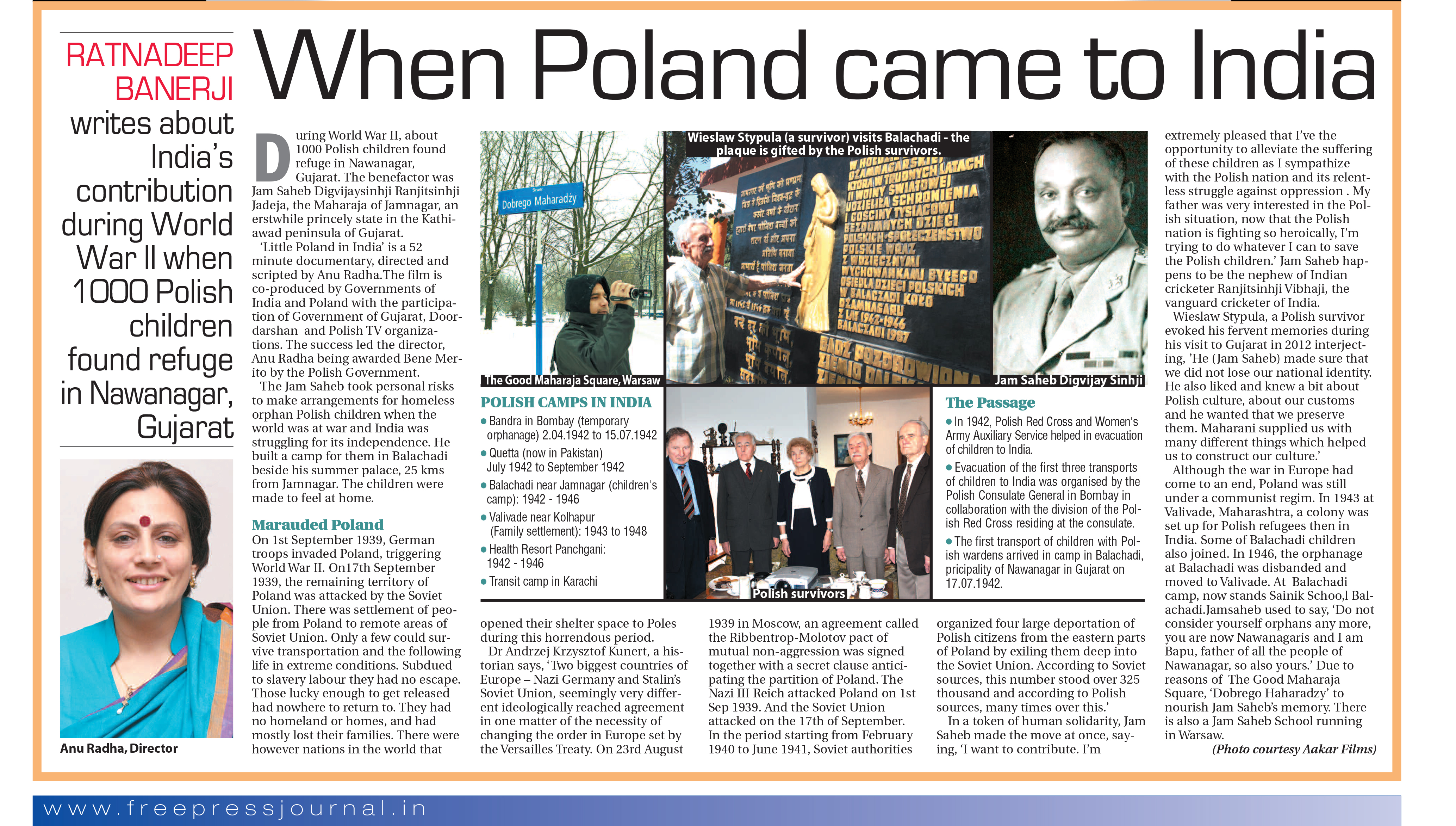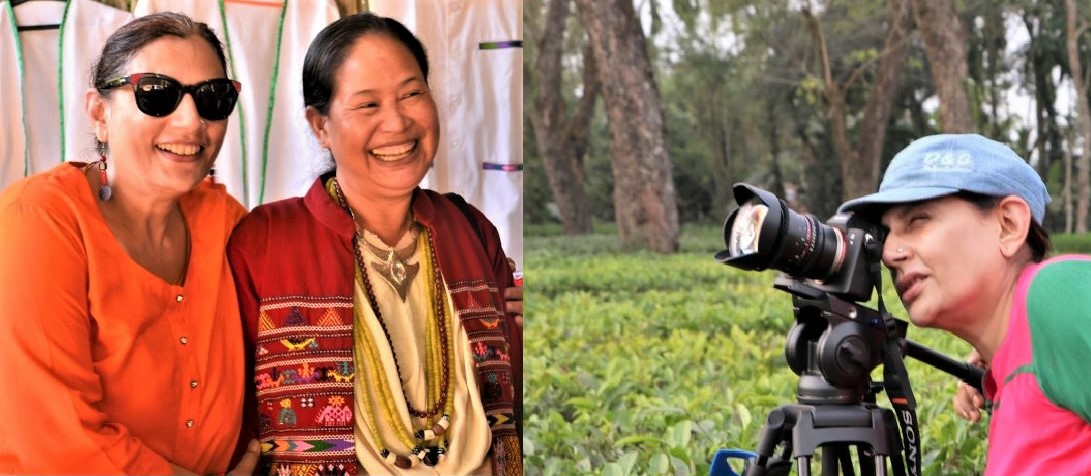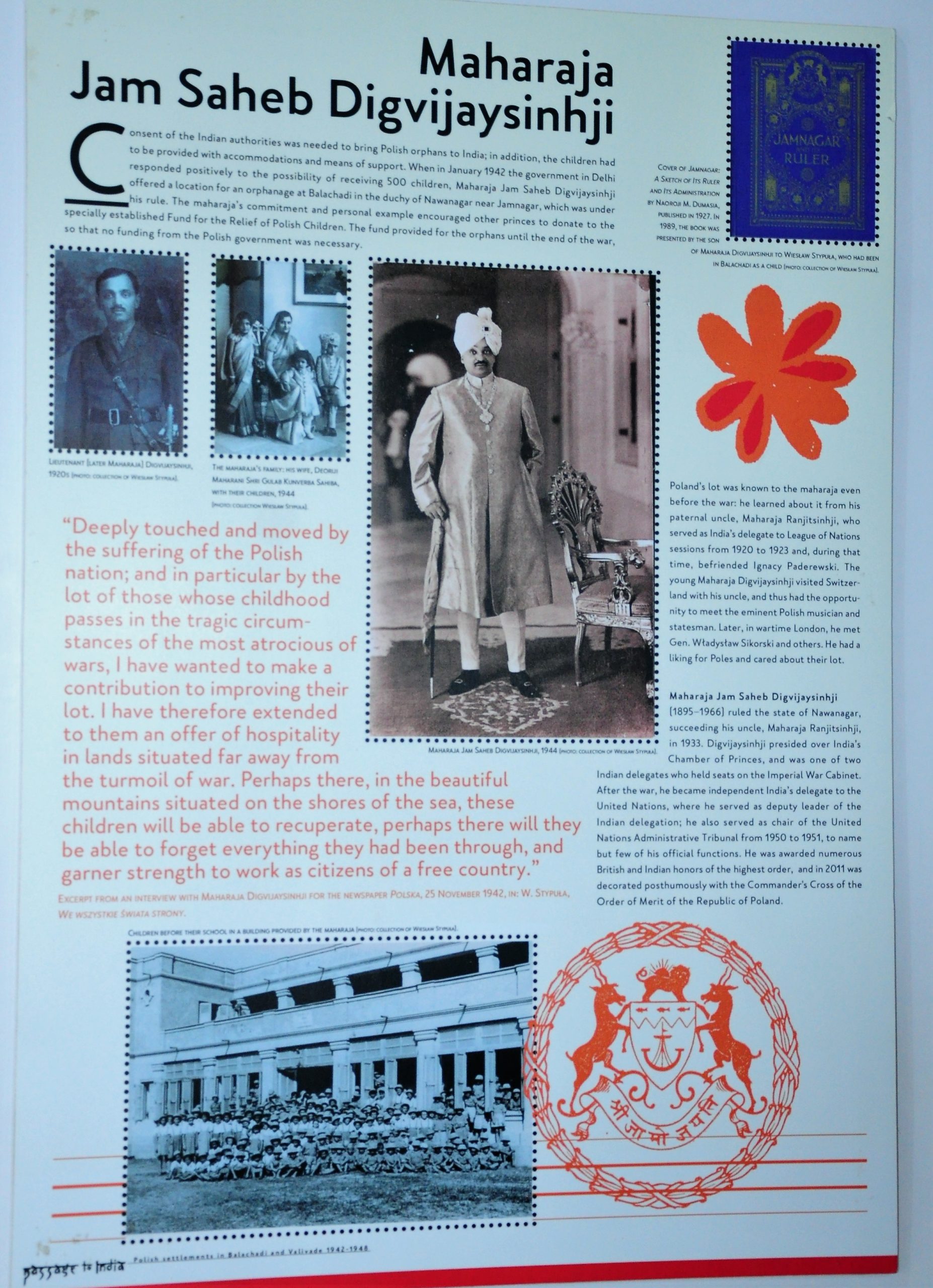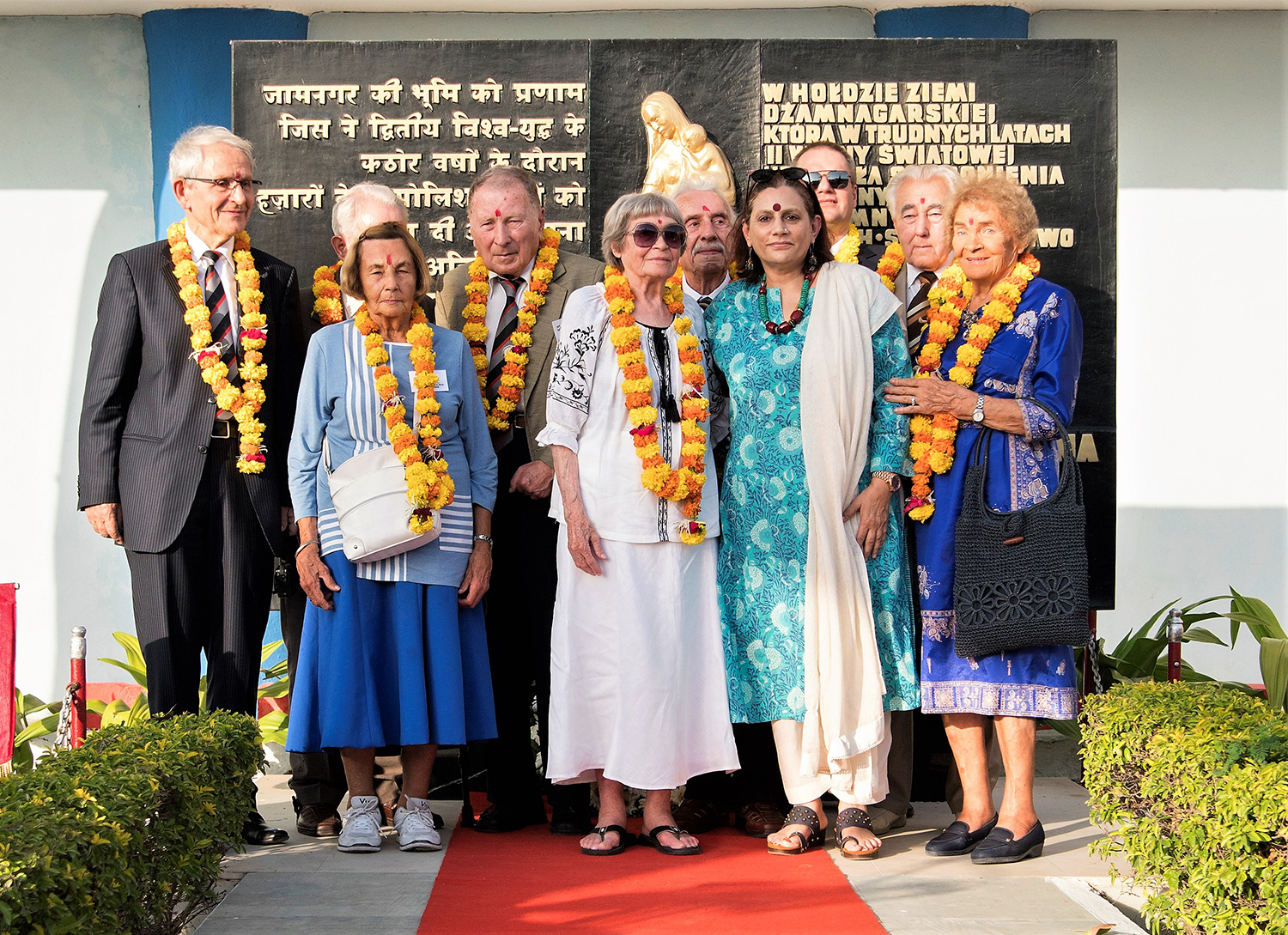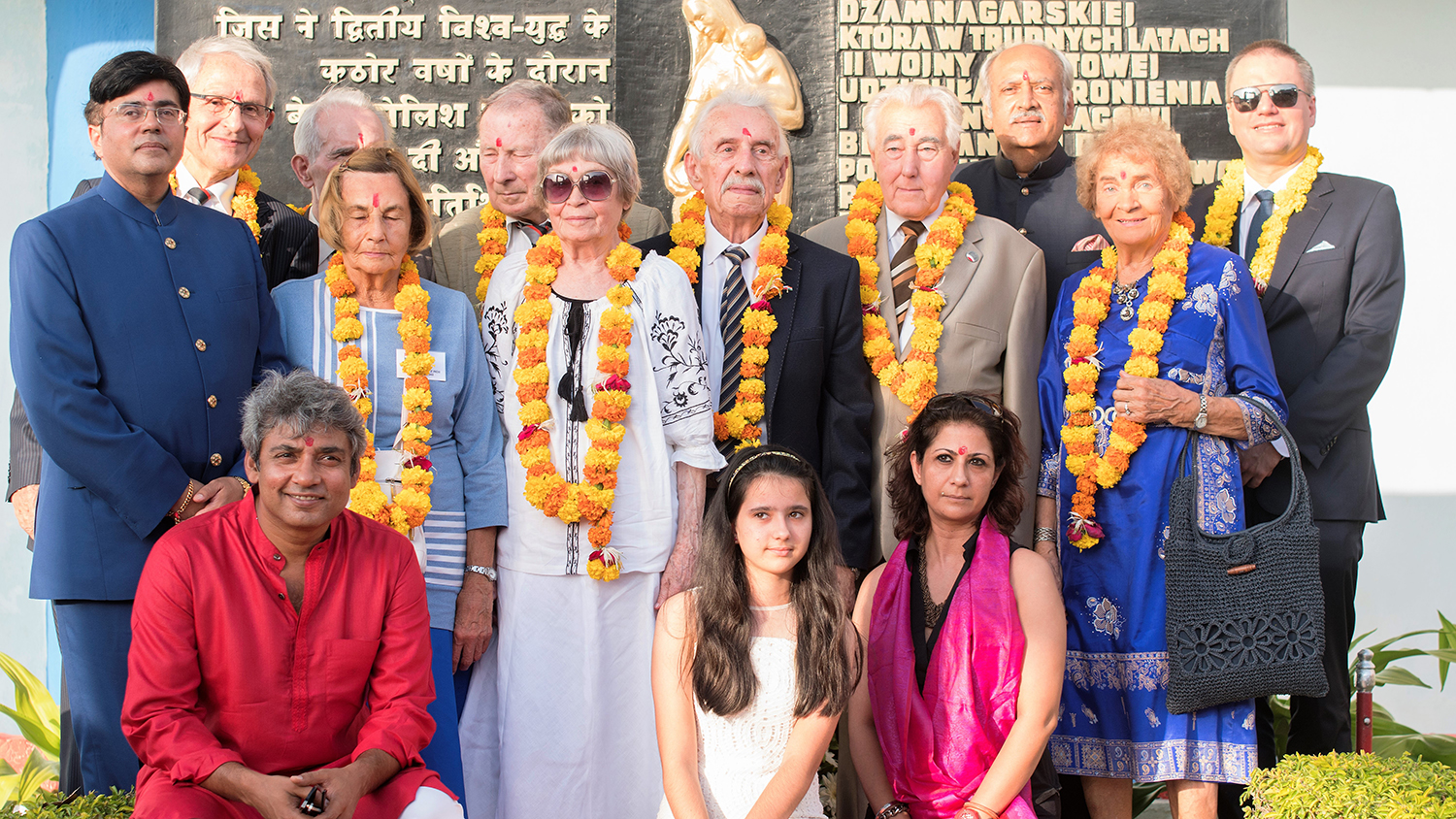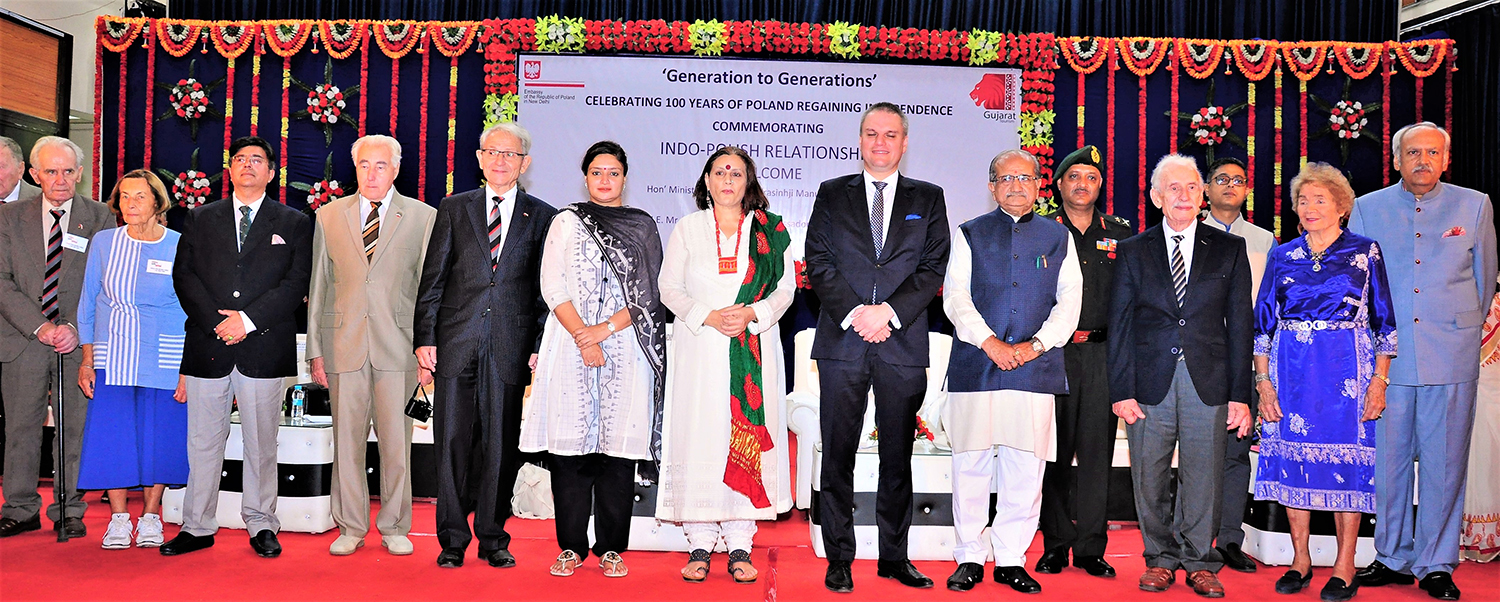Author Archive for Aakaar Films
Generation to Generations
|
The story of A Little Poland in India continues…Polish |
||
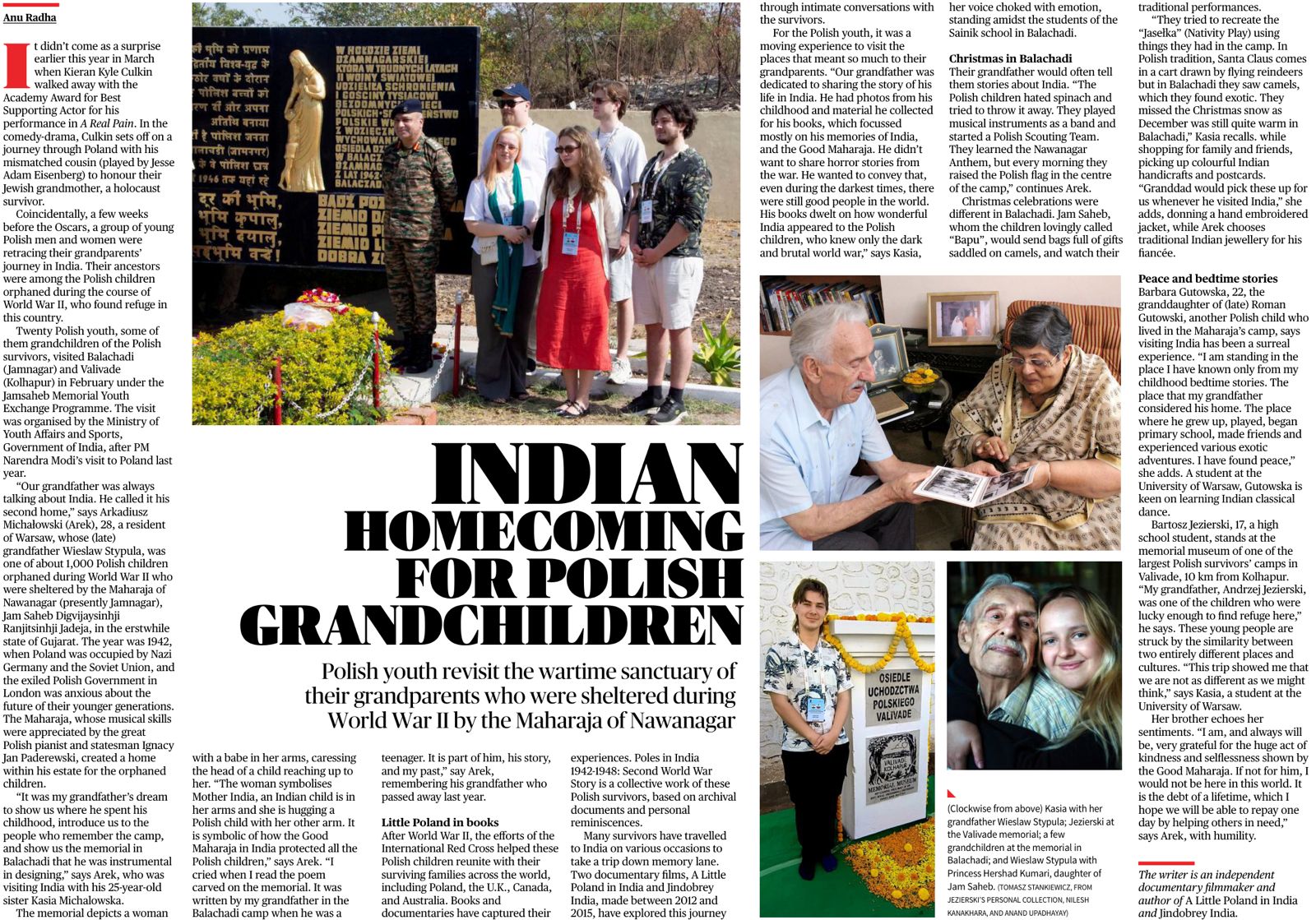 |
||
|
Twenty grandchildren visit Balachadi and Valivade, childhood home of their grandparents who lived there from 1942-48
|
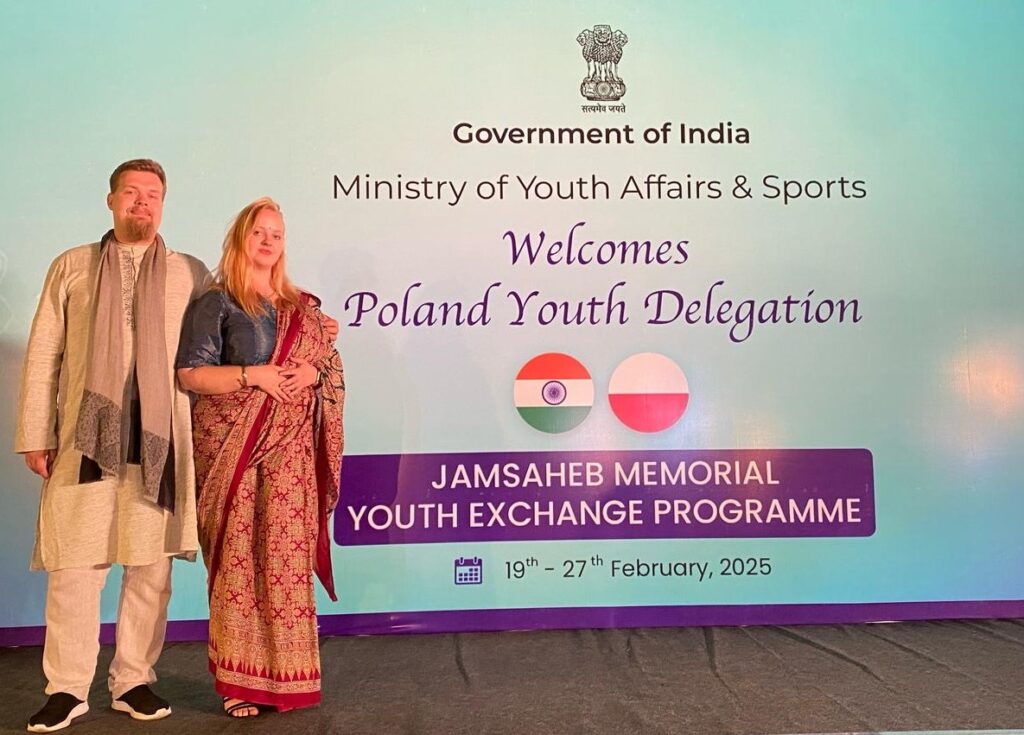 |
|
| Know more
https://www.thebetterindia.com/131681/polish-children-camp-balachadi-gujarat-world-war-2/ |
||
(s) MOTHER- ing
A word of caution: It is only about women, for women and by women. They form this lineage of change of defining Mother-hood.
Do you feel
- motherhood is the last mile of fulfilment to be defined a “complete woman?”
- creation of a child completes a “woman,” whereas men’s creativity can only fulfilled through external sources?
- for a woman, her children should be the first priority, beyond her own self?
- a mother always, in any situation, wants the best for her child?
If your answer to any/all of the above is a “yes,” then you are not reading the right space of empowerment.
The origin of this word “Mother,” “Ma”, “Mama” still remains a mystery. This mystery gets into further depth when Indian mythology brings in the definition of
“strength (shakti) with exceptional love towards all (matritva), actually merging it with defining brhamaand or the universe.
I am quite amused at the loaded responsibility a woman gets from the peripheral operational energies as a girl child. It amuses me further at the expectations of deliverables that this universal definition puts on a soul with a humane body. It sickens me to see the struggles that millions of women go through to prove their mettle “because I am a mother!”
Let us begin from the very beginning.
A girl child looks at the only female body as the first touch – it is called “Mummy”, “Mama”, “Mata,” and more in various dialects. This body does not only feed her food, but also fodder of feelings. This body generates energy that is felt by each cell, bone and marrow of the girl child, as she shares a generic wave of the pool of female-ness.
A girl turned woman is also brought up with this claim, that, that a mother always wants the best for her (can be read as for all her children). It is a far cry from the real truth.
A woman, especially in India that is not defined and confined in its Metros-exual cities, but in small towns where IQ’s & EQ’s are mis-matched, waits for that special moment where a meagre sexual encounter (s) delivers the discovery of her pregnancy. This takes shape under various situations and circumstances, few pointers as below:
- Must get pregnant with-in two years of her marriage (if not before).
Her knowledge and decisions are never questioned
- Must get pregnant, if her marriage is not working. Then, there will be no escape
- Must get pregnant by all means, as only then she is a “complete woman”
The above reasons of giving birth to a child makes her a mother by name not by actions. Such mothers, who have inability to make choice/s, choose the inevitable. They, who are already posted as weaker sections of a male-dominated society, exhibit their feebler strength on the dependent infant – her child. Thus, begins a tumultuous journey of that God’s child into hands of an (im)moral parent, called Mother. She redirects all her unfulfilled ambitions, frustrations, anger with harassment, by smothering the child slowly but steadily – till the wounds get engraved in the innocent heart for years of her youth, middle age and if not taken care of – from the cradle to the grave.
If footsteps are traced back, it will not be a surprising revelation that the violent environment of the world today, comprises mostly of these wounded children, whose bodies may have achieved adulthood, but souls have still not healed.
In this millennial, where feminism is not restricted to be defined as bra-burning women, but those who have equally empowered physical bodies, matched with their demanding desires with power of their intellectual and spiritual beauty. Such an empowered mother, who has not birthed a child into this world by giving in to pressures of social norms, but by her inner choice/s. She lives and breathes her own freedom with loving care, which reflects in an evolved empowered human being, much needed in the world today.
Mother-hood is not accomplished by birthing. That is a job accomplished by animals. Mother-ing is realized, when women adorn that role with responsibility of love and a spiritual caring.
Let us, as women, be very vigilant on reasons of bringing God’s soul into our bodies; let us, as women, pledge that body an unconditional love and caring protection; let us, as women, be cautious not to commit a sin for the highest honor bestowed on us by Grace – as SHE found us worthy.
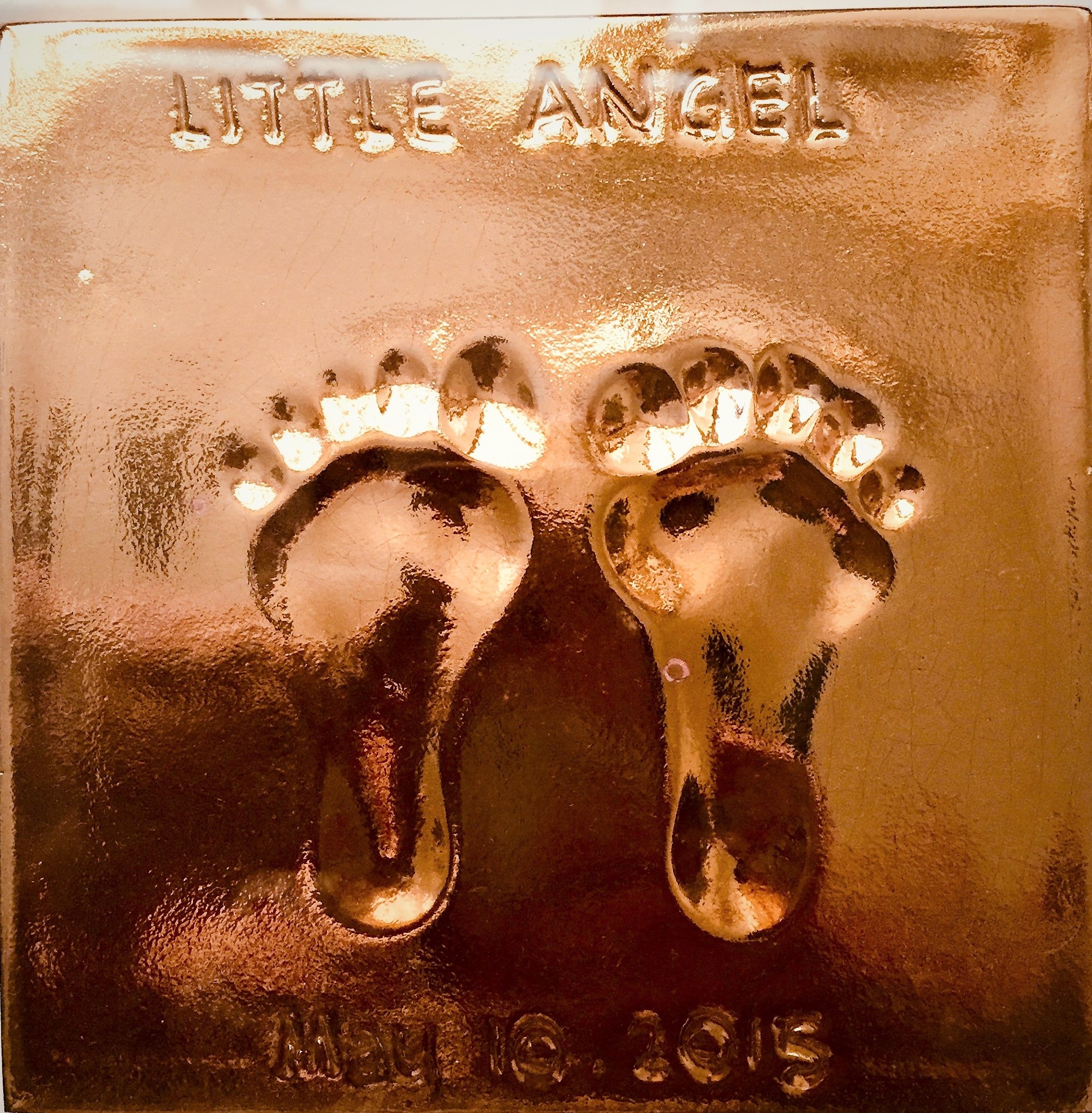
Strategic Communication
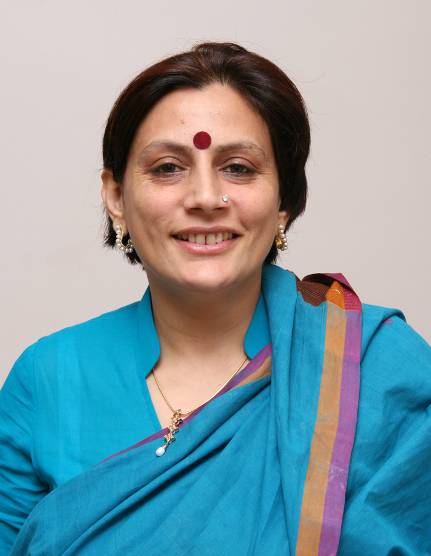
Anu Radha works as an independent Communications and Marketing Consultant with various National and International organizations. She enables clients on new project strategy development from inception to the end deliverable, execution and evaluation. She has eexpertise in presentation and negotiation skills with stakeholders from Ministerial delegations, State machinery and at the Grassroot.
Her journalistic writing skills includes Films, Scripting, Blogs and Travelogues that are based on extensive Research and Documentation. High level Event Management brings forth her honed skills of communication with multilateral partners. Empowerment across Genders reflects in her projects, writings and workshops. An avid traveler with a creative eye, she has a penchant for Photography.
National Skill Development Corporation
VOICES of INDIA, a communications and advocacy project on Skill India Mission of Pradhan Mantri Kaushal Vikas Yojana (PMKVY) with National Skill Development Corporation (NSDC), a PPP (Public Private Partnership) corporation set-up under the Ministry of Skill Development and Entrepreneurship (MSDE).
Community Radio Stations (CRS) have been established in India by Ministry of Information & Broadcasting to communicate with rural India at district level of each state in their own local language. It is an effective methodology for executing advocacy campaigns by interacting with target group that constitutes of 70% of India’s demography.
A Skill India awareness and advocacy campaign was communicated through broadcast of programs created by the community through their own Community Radio Stations in India. This required Communication workshop, enabling scripting of episodes with appropriate communication messaging, working with CRS team at locations in India, for broadcast.
LISTEN IN >> Click for Soundcloud link
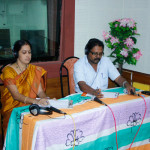 |
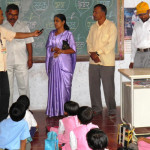 |
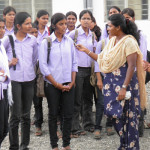 |
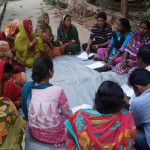 |
 |
 |
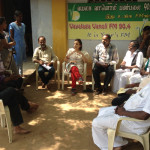 |
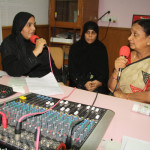 |
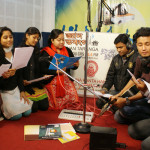 |
 |
Strategic Communications

Anu Radha works as an independent Communications and Marketing Consultant with various National and International organizations. She enables clients on new project strategy development from inception to the end deliverable, execution and evaluation. She has eexpertise in presentation and negotiation skills with stakeholders from Ministerial delegations, State machinery and at the Grassroot.
Her journalistic writing skills includes Films, Scripting, Blogs and Travelogues that are based on extensive Research and Documentation. High level Event Management brings forth her honed skills of communication with multilateral partners. Empowerment across Genders reflects in her projects, writings and workshops. An avid traveler with a creative eye, she has a penchant for Photography.
National Skill Development Corporation
VOICES of INDIA, a communications and advocacy project on Skill India Mission of Pradhan Mantri Kaushal Vikas Yojana (PMKVY) with National Skill Development Corporation (NSDC), a PPP (Public Private Partnership) corporation set-up under the Ministry of Skill Development and Entrepreneurship (MSDE).
Community Radio Stations (CRS) have been established in India by Ministry of Information & Broadcasting to communicate with rural India at district level of each state in their own local language. It is an effective methodology for executing advocacy campaigns by interacting with target group that constitutes of 70% of India’s demography.
A Skill India awareness and advocacy campaign was communicated through broadcast of programs created by the community through their own Community Radio Stations in India. This required Communication workshop, enabling scripting of episodes with appropriate communication messaging, working with CRS team at locations in India, for broadcast.
LISTEN IN >> Click for Soundcloud link
 |
 |
 |
 |
 |
 |
 |
 |
 |
 |
FLAME University (India)
Foundation of Liberal and Management Education, Pune (India) was set-up with an innovative concept of Liberal Education in India. Anu Radha was challenged in setting up and creating a brand campaign of this new concept through schools and colleges across India. This was inclusive of creating various communication strategies that were inclusive of:
- Marketing representatives set-up across India for creating awareness and benefits of Liberal Education
- Training of Trainers through Communication workshop for project execution and deliverables
- Design & development of IEC material (Information Education Communication)
- Creating an Interactive Web campaign for ease of Student communication, thus enabling admissions
- Targets and achievements through strategically designing modules of marketing
- Participation in Education Fairs and other mediums of marketing initiatives for bringing a new concept
- Assisting students who are undergoing transitions in their education process, providing information on college admission procedures
- Organizing workshops and presentations of FLAME with important stakeholders across India, including FLAME faculty
- Separate communication modules were designed for courses that saw a dip in admissions
- Financial management and evaluation of the project versus deliverables
NaMo Conversations – My experiments with truth

I was excited, nervous but confident.
HE was soft, suave and smiling.
I noticed – we were both wearing white.
HE was THE charisma for me – a small film producer, who was put on an international platform by God’s magic wand, of which HE created the First spell.
HIS voice was deep, effective but not authoritative.
I had, had aeons of experience with bureaucratic “circus” of Government-O-cracy, and hence my grey cells spelt the right words. Publicity, Positive imagery, Perfect relations on an international platform…
Instead, HE shared stories of his land and people; of compassion and warmth offered over years to each human kind; of his belief in humanity that India offered.
HE obliged me with THE PHOTOGRAPH.
I was mesmerized. And, under a spell and awe of HIM.
But, mind had its own question marks.
Then, came the Film Project – and brought problems as never before! I gasped for breath to keep it going against strangest of odds, as there was no turning back on truth.
While many Government-O-cracy supporters of the project buckled in, saving face, HIS officers lent relentless, non-intrusive support (rarest of rare in Government-O-cracy) through one of the most intense and difficult times in this international co-production film.
HE was criticized, ridiculed and put on a cross by the media and law for project support.
HE stood tall and HIS officers told me to fear none.
HE is NARENDRA MODI.
INDIA, we have HOPE in this MAN.
Isi liye – Ab ki baar, banao MODI Sarkar.
Mating of Creative Genius (es)
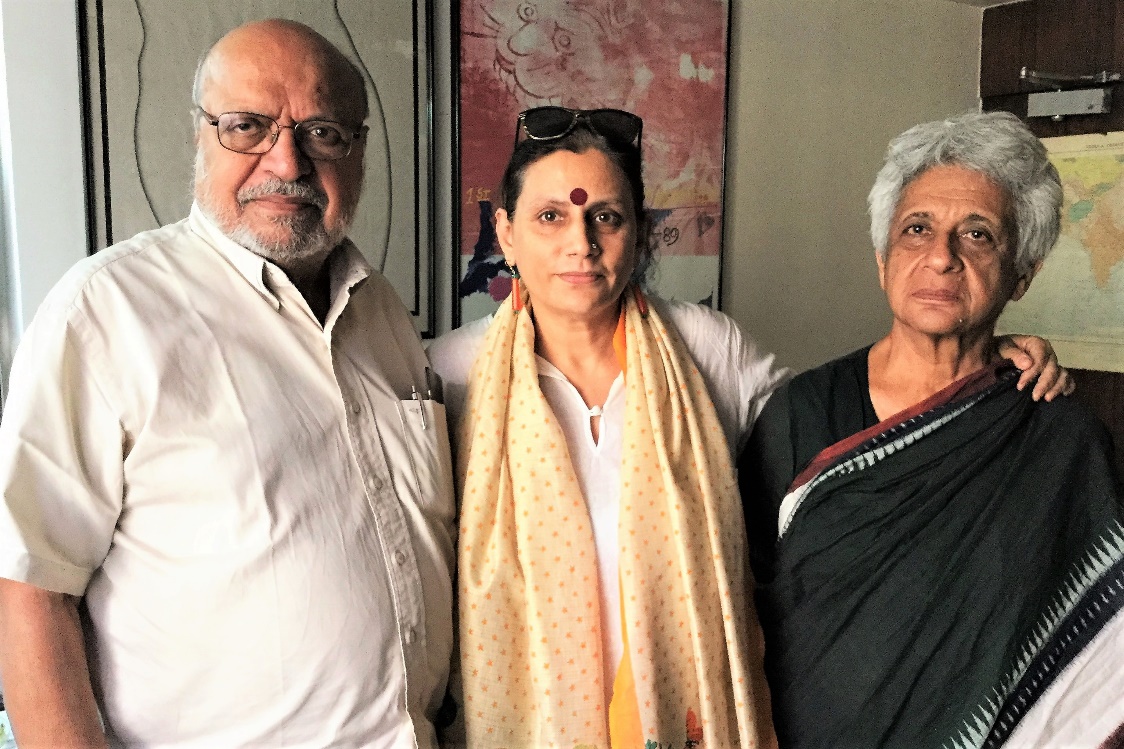
His gruff baritone over telecon was humble with a flavour of warmth. I was honoured to be invited into his official chamber in Mumbai that looked an art house. And why not? He was an elegant establishment of Art or Alternate cinema in India.
Punctual with honest simplicity, I was looking at a Film Director that was India’s pride – Shyam Benegal . His room was full of books – on cinema, history and varied others that clearly defined his stature, with innumerable Awards of highest Honor(s) received.
He was in rapt attention to my film A Little Poland in India that had brought us together with a larger vision. He gave my edgy stature respect with due professional diligence, enabling me to babble my magnum vision. Giving inputs in all seriousness made my vision seemed to be gaining a creative structure of reality as I walked out of his office.
Months passed as the vision was still blur. Besides his very busy schedule he always accepted to fit me in whenever I requested. Each time we met, his genius creativity and expert inputs gave me encouragement and kept my vision alive.
More months passed. The positive affirmations of my vision brought in some hope through the positive supportive Polish Institute in Delhi . We met again. This time with his writer – muse Shama Zaidi , who had penned most of Shyam Babu’s (as he is lovingly called in Bollywood) films.
The mating of creative geniuse(s) had begun, with my vision converted on paper by Shama ji with expert inputs given by Shyam Sir. He would patiently bridge to convey my angst to his writer-muse, saving the vision till it was ready in form.
I hold the first copy-right in my humbled hands. The names engraved on it touches my heart and gives wings to my aspiration for a wider canvas.
I have often wondered and questioned – What is it that made a larger than life filmmaker “The” Shyam Benegal accept somewhat unrealistic creative vision of a small-time filmmaker like me? I like to humour myself into thinking that he does see a potential in me with my vision?
This unpretentious humility is what makes Shyam Sir stand firm on his artistic roots, giving the world original inspirational stories of real life-cinema.
THE KUMBHA 2019
A SPIRITUAL QUEST
THE KUMBHA 2019 ALLAHABAD (PRAYAG)
– A prep for 2028 at Ujjain
You grow up with grown-ups who make you believe that there is a Heaven act good and a Hellfire for bad act (as adults see it). It is only when you yourself become a real adult, not just in age, a realization evolves defining the locations of these places is with-in, every moment of each day, as a part of your action plan called karma.
In Hindu mythology, now a belief accepted in the global spiritual quest, birth and rebirth is a continnum, and thus the journey of birth and death continues unless one goes beyond.
One of the very important decision for destination Kumbha.
As a filmmaker and creative writer, Kumbha Mela has resonated within me since the charm of hindi films entered the veins with early footsteps of teenage years. We are well aware of the lost and found generation of 60’s and 70’s “Seeta-Geeta’s” or “Ram aur Shyam” amidst varied others, that made our adrenalin rush to find the finale of bichdon ka milaap!
Kumbha or Kumbh Mela, that arrives in 12 year periodicals, by a celestial design (and some calculations!) has become a mass movement, attracting travellers from all joinres’ of worldwide settings – for reasonable and unreasonable quest and questioning. In India, it is a lifetime decision destination to go beyond re-birthing by washing away your sins in one dip (or two or many) in the sangam of Ganges and the Yamuna, with an invisible layer of river Saraswati floating with-in!
This year, my sins also decided to plunge-in to check these merging waters!
Allahabad or Prayag was where millions were heading to their calling. As my travel obsessed mind research through a faster pace of travel by air, I found none. Train travel was a passe’ since years of fastest mobility. But this time, the sins were leading my path (Ha! Ha!), and thus I booked myself with my best-ie in the best-est (Best friend in First AC) in Prayag Raj Express Train.
It was a transformational experience of its creative best! Beautiful painted exteriors, snow white sheets, spotless clean toilets – Swacch Bharat at its very best!
 |
 |
It was when we landed on the location – with a shocking disbelief, all of my visual eyes could see were heads of people on a spreadout earth matter!

It was a camerawoman’s voyeuristic delight, clicking whosoever and whatsoever crossed my lens of virtual eyes. While I, in midst of this human ocean, became somewhat unmoveable. I stood still, my eyes closed, ears strained – all on their own. I could hear was various forms of voices that were not human. And then, a call from an ancient past reverberated. I visualised my deceased grandmother sitting with priests around a massive havan kund – chanting; the chanting growing louder; and then a different musical instrument sieved through my ear buds like a bhajan; then as if saints of Darbar sahib were singing morning kirtan…the sounds surrounded me with crystal clear waves engulfing me with- in….till I was jostled out of this trance by our friends, realising that we were standing to take the holy dip!

The Human Se(e)a…
There lay a clear demarcation of the Ganges and the Yamuna – a sight that was mesmerising and deepening one’s quest for more. The boatride reverberating with sacred chats Har Har Gange was elevating human consciousness in it’s purest form. The boatman insisted that I must fill my bottle with the purest water on mother earth. Although my logic sense had refusal at it’s helm, what with hundreds bathing and sandy water, but something pulled me in to fill-up the bottle – which to my astonishment, I found not a grain of sand upon my arrival home!

In all my years, I have been unable to explain the time and journey travelled in-between till I reached on the banks of the Ganges. It reverberated of a deep silence within, where all external noises seemed to fade into an oblivion. It was later that I could relate to this silence while meditating on “Om” in years of my spiritual journey, where I moved from a verbal to a non-verbal chant, which I can now hear “Om” reverberating with-in. It was also a silence that you can feel between the sound of wind passing through mountains, when there is an absence of human foot-step. It is like the invisible love energy of Saraswati that flows between visible vibrancy of romance between the Ganga and Yamuna.
That is what you can hear at the Kumbha if you stand in stillness amidst the “shor” – it is called the sound of one hand clapping. That is Godliness.
I bathed and bathed; it was as if purity flowed with-in, washing away all my fears, sorrows and even happiness – making me serene and what I have later realised on my spiritual path – with the nectar of immortal bliss.
There is a lot more to my story with the journey into camps of unusual saints, women groups and others – but that would need to be experienced, and cannot be verbalized. That journey started the quest of another dream, which led me into reading of Kumbha, its mythological and spiritual significance. Kumbha, is much more and beyond what has been spoken and written “about it.” Kumbha, today has a greater significance than it ever did. It is this generation of youth that must be encouraged to understand its importance, linking it to the modern times globally.
When we ask the question “ Why go to the Kumbha?” The answers have all been “ to see what is;” Let us try and see “why and what there is beyond the perception of the naked eye.”
Kumbha calls me again now in 2028. I do not know if there will be survival of the body for another dip. It has changed my path into a spiritual quest. I wish the same for others. It is a life changing journey. I encourage the youth especially, to travel towards it.
Har Har Mahadev!
TRAVEL TIPS
- Book in advance. There are many variables, but for luxury tents, please check with a local to do a reccee. We were very disappointed with ours!
- Do not travel on the last days of Kumbha. Everything is dismantled, bidding goodbye, including arrangements at your place of stay.
- You will need to be a smart negotiator with Boat rides to go for a dip.
- There are many e-rickshaws available. But prepare yourself to walk a lot on sand, as the area around river is cordoned off
VIGNETTES of KUMBHA
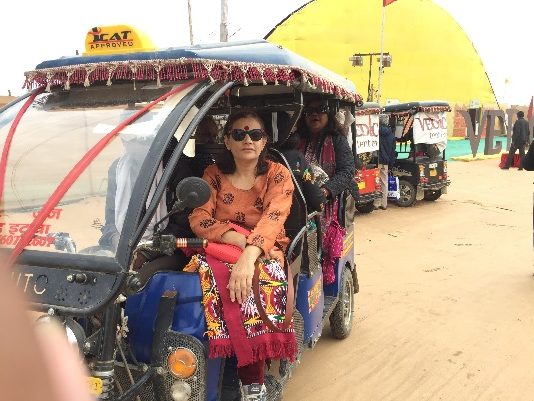 |
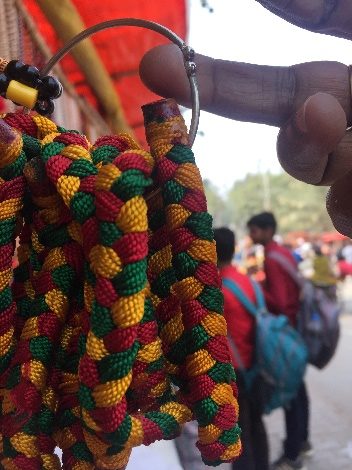 |

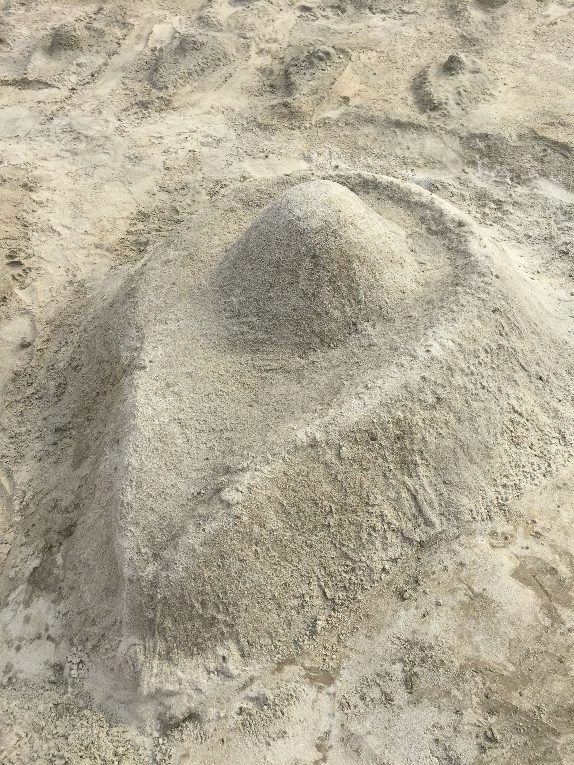 |
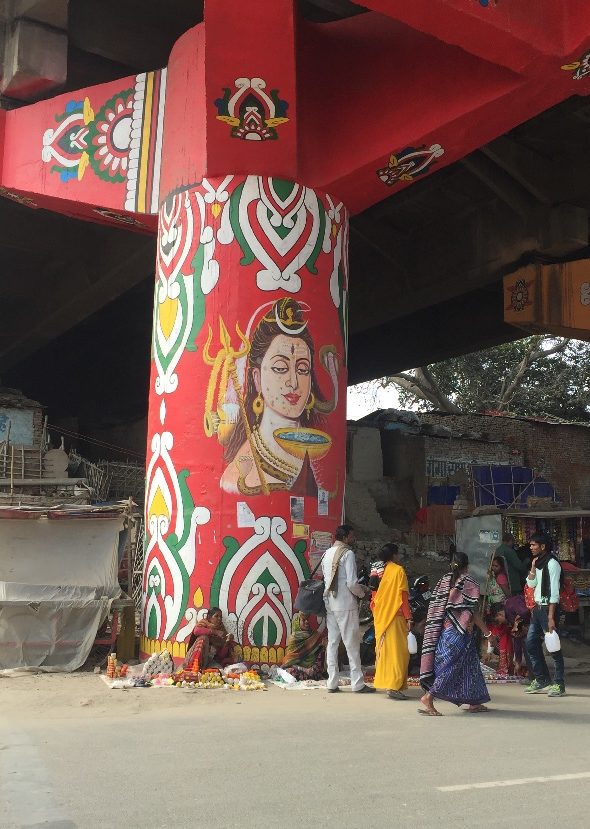 |

Old Delhi Food Trail
Old Delhi Food Trail: Hop, Scotch & Jump!
A day in the life of gastrointestinal and gustatory cells JJ
Ye dilli hai meri jaan….
Yahan ishq, mohabbat, pyaar…
That is what Dilli – 6 reflects; in its meandering by-lanes, of mysterious stories that old walls speak of an era of Shahjahanabad, the tinkle of rainbow coloured bangles with its tell-tale story of love – Old Delhi releases its fragrances not only from the itr (perfume), but also from the food trail that can be traced back to 18th century.
The right way to walk straight into the century, is to begin your “ 5 AM Club” at Paranthewaali galli with Gaya Prasad Shiv Charan – which is not the man himself, but a legacy of about 60-70 varieties of delicious paranthas, a savoury of every Punjabi household culture
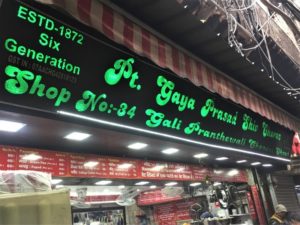
Order as you like it
“ Karela (Bitter gourd) parantha”, “ Nimboo (Lemon) Parantha”, “Mixed vegetable”….well, the list is as endless as your taste buds.
Beware of your desires: Do not load yourself full, as there is yet a long trail ahead!


THIS IS THE WAY TO FRY, FRY & DEEP FRY ……
Long and meandering bylanes not only offer a search for authentic street food, but give a glimpse of colour symmetry of bangles, hair adornments, footwear and all the “dilli 6 maal” (goods) – in case they can tempt to divert your attention for a stopover.
Although your belly needs the parantha break, but dil maange mor as your nose buds get lured into flavour of pure desi ghee at the most famous Shiv Misthan bhandar, where the queque is endless – both, of jalebis and foodies.

YOU ARE AS PROLIFIC AS THE JALEBI YOU EAT…
Your gastrointestinal cells (stomach) and gustatory cells (taste buds) have put a full stop, but your desirous needs burp ahead, as the clock strikes 1, and your passion catches 1942’s King of Naan at Kake di Hatti dangling its 18 inches deliciously cooked Naan in front of your voyeuristic taste buds.
Kake di Hatti is a small one storeyed food joint, where one finds intellectual slogan-eering hanging across its walls, giving you food and thought for life while you wait for that longest in size served naan with varied fillings that range from potatoes, paneer and a mix of onion. Not to miss the special “Maa (mother) ki daal (black lentil)” (I have often wondered, what has motherhood got to do with naming this black lentil anyways??! Answer perhaps lies in the bed of heaviness one feels after devouring it – as if you need to lie in your mum’s lap with as an immediate effect!).

 |
 |
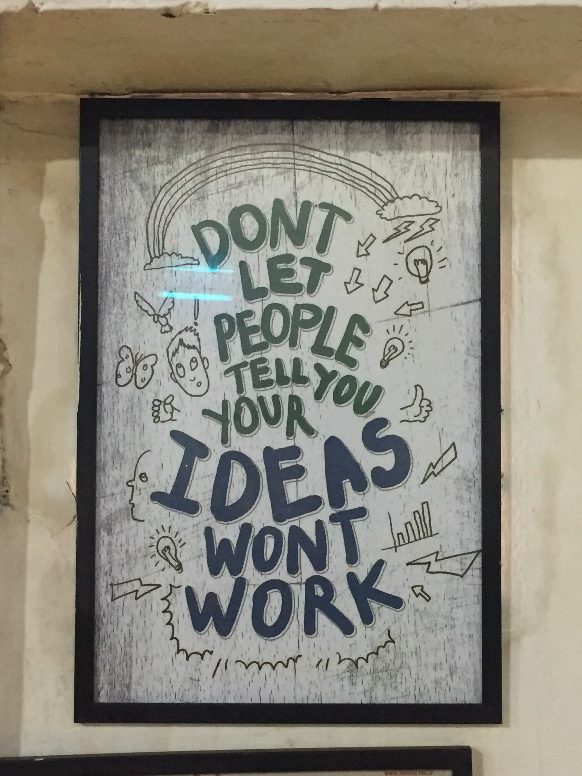 |
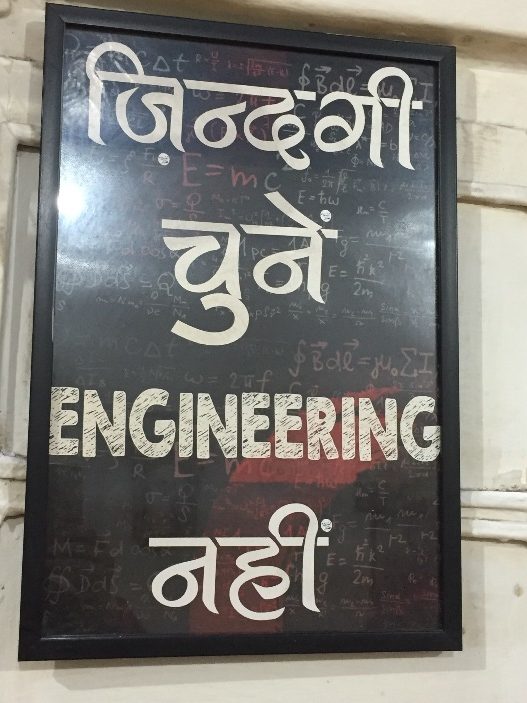 |
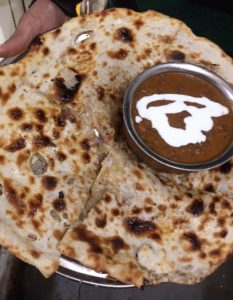
While you can barely manage to climb downstairs, with your eyes drooping, there is a nudge that lifts up your chin to catch Giani’s since 1956 that pulls your body parts with the eyes wide open to halwas – the moong daal ( a kind of lentil), gajar (carrot) and what not…..making it almost criminal, if not tasted!
 |
 |
 |
With packed bags of food hanging on a weight – loaded body, you feel almost nostalgic with pain ( is it your stomach or the heart) bidding adieu to Dilli 6 – till we eat and meet again!
A MYSTERIOUS LANDSCAPE
A MYSTERIOUS LANDSCAPE
– Arunachal Pradesh
There are some parts of the world that, once visited, get into your heart and won’t go. For me, INDIA is such a place.
– Keith Bellows, National Geographic Society
For me, after travelling almost half of the globe, the discovery of Arunachal Pradesh in India has been a Nirvana.
I feel, the mysterious land of farthest North Eastern part of India that beckoned my spiritual soul, thus enlivening each pore into a speechless sojourn. The astonishing sights after every 5 km of drive of cascading waterfalls, dazzling colours of flora and fauna sprung into surprise crevices of rocky mountains, spectrum shades of aqua changing colours as per directives of the sun – Arunachal is the destination that a travellers spiritual dreams are made of.
Journey to Arunachal is a road less travelled, due to it’s has a lack of connectivity from major airports of the country. Although Arunachal’s mystery can be unravelled from any part of the State, but I tried the most alluring route leading to Tawang lying at 15000 ft. of Indo-China border.
I stepped into bordering State Assam by flight from Delhi to Guwhati in the misty weather of October-November, the best time to visit. Picked by my friendly companion driver Aziz, my spiritual quest was to visit the very famous Kamakhya Devi (Godess of strength and valour) in Guwhati. Kamakhya history is seeped in mysticism, occult and tantric traditions of Hindu religion, with some ancient and medieval facts that relate from 8th to 17th century.
The temple Godess or Shakti proclaims a sacrifice to be done at her altar, which I refused to do so, as I believe that no sacrifice of an innocent animal is required to please the “Mother” Kamakhya. It’s traditional Sindoor or red vermillion, which is supposed to be a blessing for desire fulfilment from the depth of its garbhagriha (cave like structure with-in deep down mother earth) which has shape of Yoni (female genital – that I could not see in the darkness of lamp light), was what I considered a blessing from beyond.
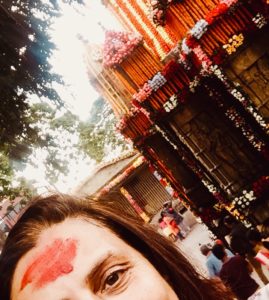
After an auspicious beginning, my climb to Arunachal was a 10 hour drive from Guwhati to Bomdila, with-in the most swirling roads that led into a steep uphill task of my big vehicle, a must for driving anywhere around Arunachal Pradesh. The long drive has never a tiring moment, as one is rejuvenated by nature’s gift of flora and fauna adorning the trees that bow down to welcome you to this land.
With its borders giving you a glimpse of Army camps at various places, Bomdila lies in the North-Western part of Arunachal Pradesh. A quaint town and a district headquarter, Bomdila is the seat of one of the largest monasteries of Arunachal Pradesh, besides famous Tawang. Gentse Gaden Rabgyel Lling monastery, built in 1965, it is situated at 8500 hundred feet above sea level. Young Buddhist lamas are taught the spiritual nuances and these young minds have a laughter of a thousand Buddhas.
Kamakhya Blessing

At Bomdilla Monastery
I was blessed to have had the opportunity to celebrate my most auspicious day of birth amongst the chanting of lamas in their prayer hall under the Buddha’s glorious blessed feet. The Monastery celebrates it’s annual Mask Dance festival, and the colour of demons with dramatic musical background score – is once in a lifetime experience, not to be missed.
 |
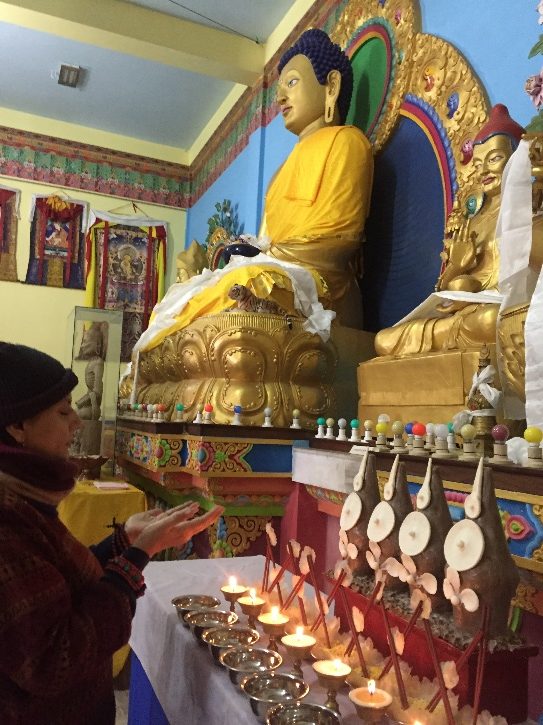 |
BOMDILA MONSTERY

The hospitality of Armed forces, with their disciplined extension in their personality and surroundings have kept the land of Arunachal as nature had bestowed – ‘sparkling’ clean! Be it the majestic mountainous paths or the water gushing across meandering roads, the Army jawans are deputed to keep the ‘gift’ of nature, blessed.
In my fortunate journey, I was welcomed by Major BB Thapa and his colleagues on a tour of their border and given an opportunity to salute the martyr at 10,000 ft. besides a served sumptuous breakfast that was truly a treat after having eaten boiled food for umpteen days – as a vegetarian, you have minimalistic choices! As a civilian, one constantly hears the stories of the tough life of jawans bordering and protecting, but it is only when one sees their living braving the terrain and weather to stand erect under any adversary, the hand spontaneously goes up to salute the brave!
 |
 A SALUTE …. TO THE BRAVE A SALUTE …. TO THE BRAVE |
No journey in Arunachal can be complete without a visit to Buddha’s land and birth place of sixth Dalai Lama, Tawang. The quote “journey is the destination” stands as epitome of truth while travelling from Bomdilla to Tawang. Crossing small hilly town of Dirang, with its farm cultivation (more popularly called “Jhum”) on hilltops, leading to a tough spiral terrain, you climb and enter “the clouds.” It is as if God’s have bestowed all the gifts they had to welcome you into their land.

BEYOND THE CLOUDS
Sela Pass is one of the many examples of this Grace bestowed, where words fall short of any explanation, thus I thought it best to put photographic expressions of how the lake changes its colours with the movement of the Sun.
O! SELA PASS

You also cross to salute the brave soldiers of Indo-China War of 1962 at Jaswant Garh where a 24 by 7 food canteen is run by the soldiers who still believe that their “Hero” Jaswant Singh, who fought alone to keep the enemies at bay, lives on. A hot cuppa of free tea is a must sitting on the hilltop, overlooking deep abyss from Jaswant Garh.
A 5 hour long journey finally brings me in to Tawang – at 10,000 ft. and a mesmerising sunset, blessing the land of the Buddha’s.
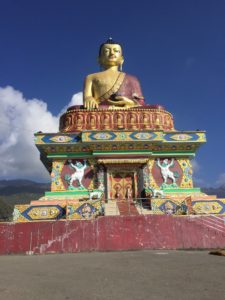
The Big Buddha
Tawang has a flavour of people; the small bylanes of local cusine, colourful clothes and Tibetan-Chinese cutlery – it comes alive at its annual Tawang Festival held every year in November.
 |
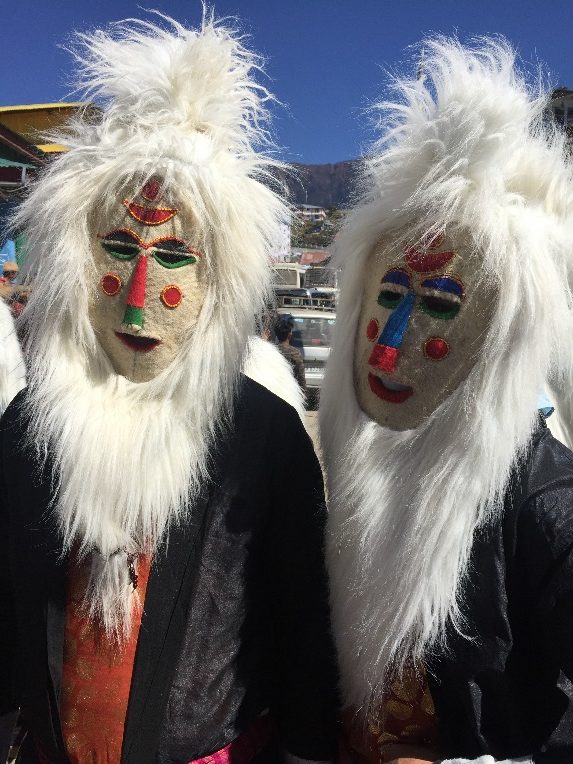 |
Tawang’s destination search for every traveller finds its completion at the Indo-China border, where Indian Army man’s its bravest of the brave to guard its borders. Thanks to extended hospitality of Major Thapa, I am treated with hot “halwa” ( a traditional welcome dessert) at the height of 15000 ft.and seething cold wind that seeps through your skin even if you are layered all over!

MESEMERIZING ENROUTE INDO-CHINA BORDER

Frozen Lake

INDO-CHINA BORDER: THE BUMLA PASS

Surprise! Surprise! Airtel China at the Border!

MADHURI LAKE named after Bollywood Diva Madhuri Dixit who filmed a popular Bollywood movie song in film “Koyla” with Shahrukh Khan, is actually called Sangestar Tso Lake – Divine!
The tough terrain, manned by thousands of soldiers across Arunachal, their devotion and dedication to safeguard our lives at the cost of theirs, raises my heart and hands in eternal salute!

Caution: Arunachal is a tough journey to do for any regular traveller, who has no penchant for adventure and discovery. But if you are ready for self-discovery and a spiritual quest of nature’s undiscovered paths – Arunachal enlightens and beckons you. So gear up the courage with-in, pack your bags (lightly) and drive-in to the elusive border of India that is truly “Land of the Rising Sun.”
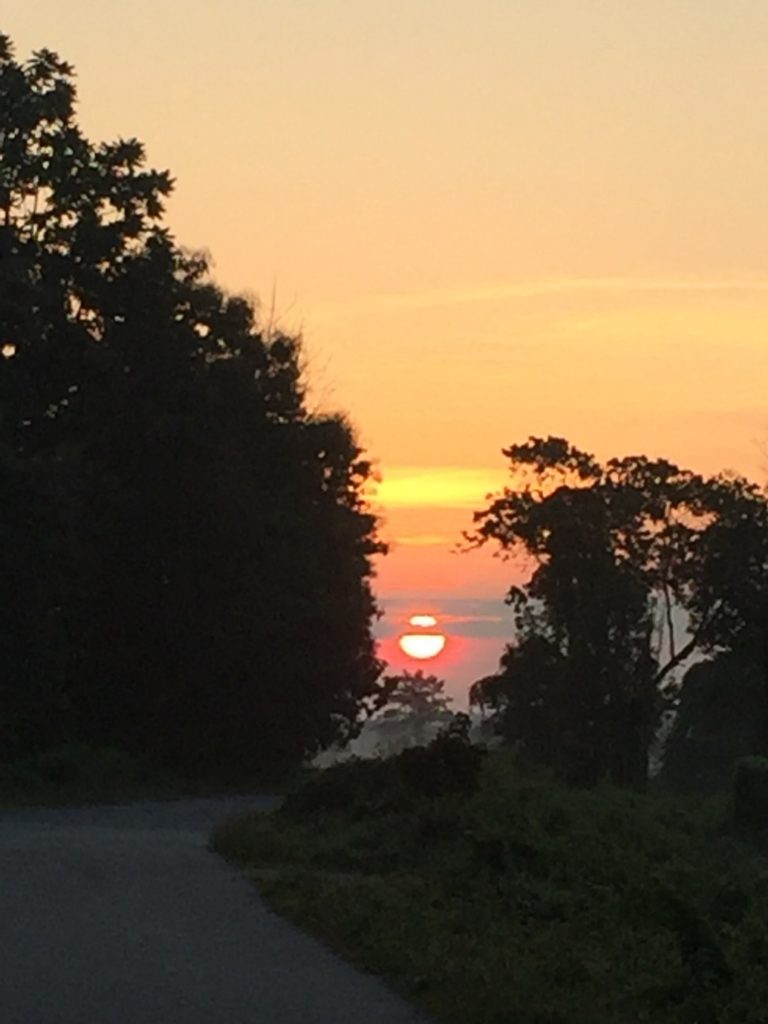
There could be no better way to End your journey at Assam’s Kaziranga Wildlife Sanctuary and view the one horned Rhino at close quarters riding on an Elephant!
 |
 |
SUGGESTED ITINERARY FOR THE WANDERER
Delhi / Kolkata – Guwhati (Most India’s National carriers fly in)
Guwhati – Bomdila (by Road is the best and safest way to Drive On to Arunachal). There is an Air India flight from Guwhati – Tezpur (half way down Bomdila) but it mostly gets cancelled.
Bomdila: Stay for 3-4 days; Stay at Hotel Siphiyongphong, where hospitality and locations is at it’s best.
Dirang: You could also Stay at Dirang which is 2.5 Hrs away from Bomdila. But, that is only if you are on a silent retreat!
Bomdila – Tawang: 5 – 6 Hrs by Road
Tawang has many Hotels, but I stayed at Hotel Tayatha, which was superb!
Tawang: Plan a 4 day trip if you want to rest your back and visit all locations at your own pace to immerse in its beauty.
PERMISSION: You need an Inner Line Permit to visit Arunachal. This can be applied online (http://arunachalilp.com/)
BEST TIME : Mid October – November
Do book your travel (Hotel, Vehicle) 4-6 months in advance, if you want to visit Arunachal at this time of the year. Vehicles must be booked from Guwhati.
AKA’s – In the land of Rising Sun
“I married eight times. There are five alive now. Three have died. But I have not forced anyone. I like the woman, she likes me, that’s how I get them. I got eight. In cities people have many women hidden, leave them and then get another. But in my life, whosoever I married, I have shown the world and kept all of them,” is what Govardhan Nimasow defines polygamy, much legalised within the community of a rare tribe of Arunachal Pradesh – the Aka’s.
Arunachal Pradesh, a State in the North Eastern part of India, can also be termed as one of the largest tribal belts, hosting 26 major tribes with about 100 sub tribes. A virgin ecosystem, Arunachal is an exquisite journey of nature’s splendour – with waterfalls springing across tall mountain peaks to mystical lakes shimmering with icicles on varied shades of blue hues dancing to sun changing positions as well as, chanting monasteries.
Amidst this sojourn, I meandered into the most visited part of Incredible India, constituting of the Bomdilla – Tawang – Indo – China Border route. It was on research of a tribus clan of the Aka’s, whose history and geography are as much hidden as their origin. Aka’s history is veiled in mystery. “The time period is difficult to mention because there are no records. In the mythology and as per the narrations given by the village elders during the field study when I conducted, most of the village elders have narrated in this way as this is the origin of Aka’s,” says Dr Gibji Nimasow, Professor and researcher at Rajiv Gandhi University, Itanagar. An Aka tribal himself, Dr Gibji’s research constituting of books, periodicals, journals on the tribe are a rare insight into history of Aka’s.
Although the legend goes that they carry a lineage from Mahabharata, the Indian epic, claiming their ancestors living in Pratapgarh on the banks of Giladhari river, north of Bishwanath and were ousted from there by Lord Krishna and Balram – thus migrating from plains to the hills due to this feud. “That’s a story,” says Gibji with a smile. “They actually came from Tibet side, settled down towards the plains, to again return back to the mountains.”

An AKA Village
 |
 THE AKA’s THE AKA’s |
Mountains of their abode, belongs to a tough path towards Southern Kameng districts of Arunachal – a long six – hour tough journey from the district headquarter Bomdilla. The realisation came, when I decided to uncover the mystery of the tribe while travelling towards three of their villages that lay hidden amongst dense forests and hilltops of roads built on boulders. Thrizino, Palizi and Subu beckoned me into their lap of natural habitat of colourful Aka’s.
Aka tribe, all of ten to fifteen thousand in number, are divided into two main sub tribes – One is Hrusso and another is Koro. Those who are inhabited in West Kameng district, they are known as Hrusso and those that are settled in East Kameng district are known as Koro. There is not much difference culturally speaking, but the difference is only in dialect. The dialect which is spoken by the Hrusso sub tribe is different, totally different from the sub tribe of Koro.
Arunachal Pradesh is gifted with one of the richest biodiversity in the world where the religion of the Tribals belong to “Land, Forest and Water”
Since generations, tribals have protected all three in various indigenous ways that the world today needs to learn as a part of conservation ecosystem. They have a symbiotic relationship between forest ecology and the livelihood of people.

The Hilltop Dwellers – A typical Aka House
“Our core belief is the practice of Nyezino, which is combination of two Aka terms, Nyez means sky and No means Earth. We call them as Thow and Gew – Thow means rearer and Thow means feeder. This makes us believe that all the mountains, river sources, big stones, big trees and all, has their own owner. We have to do something, we have to extract something from that area, then first of all we have to appease the owner of the land. Then only we can go for extraction or exploitation of that area or the “spirits of nature” will punish us,” says Miali Sidisow, an Aka social worker who keeps telling stories of the tribe to younger generation “so that we do not get erased in the modern world.”
Aka’s have their own laws of administration where crime and punishment are served in traditional ways – that is set-up by the village elders called Gaon Buda (Village elder) since generations. A thief is judged by the traditional village council is known as Meye that consists of Headman called Bagha with two gibba as aides with compulsory representation from each household.

AKA VILLAGE COUNCIL called Meye in progress at Subu Aka village
The meeting began with a traditional breakfast, cooked and served by beautifully dressed Aka women of that village, creating harmony and togetherness for beginning of this day. The place for holding all meetings Nyetrii Psigha considered sacred is prepared traditionally, for council and other festivities.
The Bagha makes rules in consultation with the tribe in the village council which is mainly threefold, judicial, administrative and developmental. A thief who had stolen, was present at Subu Aka village, led by the priest and then to a location in the forest. The admittance of punishment will decide the fate of the thief. After a brief prayer ritual, the thief has to walk within the bamboo laden with thorns and put his hand inside bamboo containing boiling water.
His denial to both, is proven guilty… thus justice served.
“There are certain things that are imprinted in the culture of the Akas where the role of priest is very important. As the number of priests are declining, Aka’s are facing difficulty in performing all rituals – be it administration, marriage, hunting or any other. Priest cannot be made. We believe that priests are transferred from one generation to another,” explains Dr Gibji.
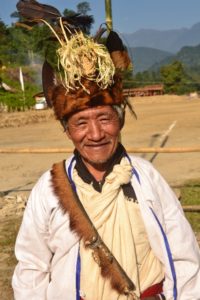
One such rare priest that I had a fortunate bid to meet and film with was Jampra Desisow, who explained how long traditional yet modern marriage ceremony is conducted for six long months or more. Aka’s have never heard of an “arranged match” as it is always the freedom of the girl and the boy to choose their own partner.
“ On knowledge of the son’s preference, a negotiator is sent by the father to the girl’s home. On mutual agreement, the knots in a string are tied thus fixing a date based on the last knot, for the marriage ceremony. Mithun (resembling a buffalo, being the most revered animal of the Aka’s), is the gift from the groom, with the bride’s family equally honouring by return gifts carried to the groom’s home,” states the Priest.

MARRIAGE CEREMONY IN AN AKA HOME
All the women of the village had beauty tattoed on their faces. Termed sachiphiu, tattoing is the nomenclature of this tribe with its distinct identification and separateness from neighbouring tribes. Traditionally, the girl reaching puberty is tattoed thus barring her from eating meat, till her marriage. On the marriage eve, as the girl enters the grooms home, she is fed meat by the groom amidst celebrations.
 |
 |
TATTOING or Sachiphiu AN AKA GIRL ATTAINED PUBERTY
Polygamy seems to be the norm of their lives, with a well-to-do man taking on as many as 5-10 wives. They call it by various names, such as Sarorate – man marrying wife’s sister, Levirate where the woman marries husband’s brother after his death and Edogamy where marriage is within one’s own social group giving tradition of a preserved cultural lineage.
“These traditions are slowly fading away, as education of younger generation, is calling it evil system of disempowerment,” says Sang Dorjee, an Aka political leader, who also leads self-help groups to make women aware of their rights.
But within the home and life of five wives of Govardhan Nimasow, the scenario I viewed was an amazing milieu of love and laughter. “ We feel like we are in a girls hostel,” says his third wife Netan Nimasow with a childlike laughter.“We never fight,” says wife number five Jabom Nimasow, “We respect what the elder didi tells us, as she shares everything.” There was an empowering openness on discussing sharing of the man. “ When my Mr. keeps his headgear in my bedroom, I know that it is my chance to sleep with him that night,” says Netan without a blink of her eyelid, which would put disempowerment questionable.

GOVARDHAN NIMASOW, HEADMAN PALIZI AKA VILLAGE with his FIVE WIVES
Aka’s women are empowered as they hold rights to Agricultural land, are in the Gram Panchayat, speak fluent Hindi with younger generation going to school. Their farming on high hilltops termed Jhum has all its produce organic, as explains Rinchin Dema, an Aka farmer woman on why burning crop does not cause pollution. “First we cut the grass and dry it for a month, then make fire lines, then we burn it. We then see the land and then decide what should be planted in it. In some places we plant rice, in some we plant pumpkins, some places we plant sweet potatoes, some places we plant colocasia – basically we plant according to that particular land’s suitability. The benefits of our Jhum cultivation is that when we burn fire lines, the ash is used as pesticides and fertilizer unlike what you do in your cities. That is why we do not suffer from many diseases,” she ends with a satisfied grin on her beautiful face.
Aka’s lives are celebrated inspite of their lack of luxurious lifestyle, which they are unaware of. Their simplicity of innocence is showered by the natural ecology that surrounds them. They believe that “hurting a leaf and a stone or water without its permission and prayer, will hurt our homes” and “hunting is only for food whenever necessary, but 10 day penance is done if any elephant, tiger or pregnant deer is killed by mistake.”

FILMMAKER ANU RADHA with an AKA CRAFTSWOMAN
Master crafts men and women weave clothes and headgear from the local produce. Aka dress pasa is self – woven from locally grown plant mumdra; Man wear a small garment hanging below the shoulder to the knees, with a long piece tied to the waist termed Shashi Chupeo. A coat woven in rough cotton hanging from shoulder to waist called Shashi-pholu, with undergarment termed Wopu. Women wear a garment that hangs from the shoulders and red coat Shashi pholu colours them bright. Legs are covered by a piece of cloth called Gudu, giving protection from dam-dum flies, which cause acne swelling in the whole body. Unique headgears miisanga and ghaga adorn men while women being women, adorn themselves with exquisite traditional ornaments. Bamboo is their livelihood, with all its produce woven for household usage as well as, protective gear.
Music and dance are an inherent culture in the life of all tribals, so it is with Aka’s. Invited to see their biggest celebration Nyetrii Dow is a colourful feast to eyes and a dancing heart. “Nyetrii Dow festival for us is important because our Aka tribe villages spread all across, Nyetrii Dow is special as we meet each other, know each other; relatives who stay far meet here in Nyetrii Dow festival. We pray to God that our harvest should be good and all village people should be protected from any disease, and we have blessings from God,” says Hima, the Gram Chairperson dressing in her finery.
 |
 |

DANCING, DRESSING & CELEBRATING – NYETRII DOW FESTIVAL
There is a lot of teachings and learnings as a takeaway gift for an urban wanderer. The dense greenery with meditative silence where the only sound is of a rare insect or a natural waterfall which transforms and is preserved as a swimming pool, with majestic mountainous peaks over small hilltops laden with stones – Aka’s reverence to their ecology, is a study map for world’s conservationists.
NO. Gender. Abuse.
A reader may be perplexed by the use of a title that leads into a scratching mind-game, as an intellectual would term it. Are you? Well, let us dig a bit deeper into defining it – word-by-word.
NO: No Objection; No Ownership; No Oppression; Or simply, NO.
Gender: Male or Female, right? Wrong. To be read as: Bisexual, Straight, Gay, Transgender
Abuse: Four letter words? Nah! Although I shall expand this later, but it begins with the silent communication through five senses. Touch, Smell, See, Hear, Taste.
Make a Connection. Say NO to Abuse by/for/of any Gender.
Let us start to define abuse, and when does the seed become the germ? Flashback your lives to the time where memory fails. If you have a bright spark, you may reach age 4.
Abuse begins much early. It is when you make a choice of a set of parents to be born – as seers would say, to learn some lessons/karma theory. It begins when you are just planted as a seed in a mother’s womb. How you get planted, is where the case in question begins. And, make no mistake. It is not only if the male participant was forceful/ rapist/non-accepting (of course, most cases it may be the patriarchy) in the ‘act’, but the fe-male (physical body of a woman may have more of male-ness in with-in) can also be the violent role-player of being intrusive, obsessive and passively-active into forceful impregnation.
This is STEP 1 of Abuse. Of which, you are a helpless victim.
This helpless-ness is a continuum by so-called “adults,” and should be forgiven till you become an Adult – in chronological age, not necessary in being.
Till you reach a reasonable adult age, approved by legal honchos, of 18 years (now is reducing in a quick time space of a 12 year old, as I they open their mouths and minds!), you are in a constant abusive space of adults – homemade parental weapon wars (weapons to be read as mouth, hands, feet), grandparents ego-ic (misnomer termed heroic) saviour behaviour patterns for their own kin (son or daughter – you don’t matter, a child!), neighbourhood prying judgemental eyes (ill- legal guardians of this galaxy’s correctional therapists), school teachers (moral in their own immoral behavioural patterns of control therapy), relatives (to be read as incest infusing freaks), and so on so forth.
This is STEP 2 of Abuse. Again, you are partially disabled/challenged child-adult in the situation. You are dependent, and forgiven with scars and wounds that will now attract more of it.
It is here one has to learn and unlearn.
Learn definition of Abuse, while unlearning it.
So let us use a case in scenario. You have lived through STEP 2 and now are in the world. Let us say you have checked all the correct boxes – done well academically, socially and have become master of many masks ranging from scholar badges, parents presenting you as their achievements in the drawing room conversations as well as, you have stepped-up by wearing the toughest mask of a Happy Family/ Family is most important/ Family holidays so on and so forth.
Technically, you have a body of a man or a woman as the third gender (if it was in STEP 1) is already wailing somewhere else. Your scars/ wounds are well covered/suppressed in some corner – till you stand on the threshold of fresh abuse of a partner.
Here is where Gender will do a walk-in.
Thus, a straight (if straight really knows their sexual preference) will have a partner termed “boyfriend” or “girlfriend”; a gay will have same sex partner; a transgender will be oscillating still trying to fit-in.
Let us also bring the NO here, that we had left behind. All definitions inclusive.
If your partner makes you feel any of the NO definitions, you are being Abused. It may be as subtle as uttering a “you don’t know anything so shut-up” (with a cynical laugh or in an anger – you have been abused. If you accept this, abuse raises it’s bar up by moving into “who has more power mentally and emotionally” (physical does not need a mention, it is so gross!).
Let me define mental & emotional power games that adults play, any Gender.
The male gender of course has (never had) no sense of any spatial boundaries. As HE owns it all. Hence, if you are a daughter, you are owned by a father and a brother; if you are a wife, then the ownership is shared between father, father-in-law with mother-in-law and son/s; if you are a working woman outside your home, this boundary extends further in hierarchy of male-ness in the surrounding spaces. You are in the last rung of this long ladder of self-proclaimed owners, who stand on your shoulders (or wherever they can find a foot-hold) and then expect your to move their ladder the way they want.
So it starts by, “I have to ask my husband/father/brother/son as they may not like it,” to a very simple act of going out with friends (ok – girlfriends!) with a fear factor of doing so without permission and then justifying “his” unjustifiable anger upon return – “He is right, something may have happened; he is just being protective as he loves me.”
This is not love. It is an abuse of power. Simple.
While Male-ness have played this game for generations, now the power abuse has also shifted it’s position to the so-called (dis) empowered women, demanding equal male rights (as if it is a star quality!). While the bedroom politics has shifted ‘positions’, women assert that even if they are not working outside of their homes, the partner (who may have a 12 hour job) must do 50% of sharing home-work – Just Do It baby! Men/ husband suffer the insufferable, as they do not want to have a verbal chaos after a long day/night job OR some smart alecs start “travelling on work,” to have some peace in their lives.
This is abuse, Man. Get out!
Now, let us focus on Love. The most used and abused word/feeling/relationship.
The so-called lovers come in many forms, in various packages.
The 18 – 30 years: We meet; we “discuss” in coffee lounges/hotels rooms/parks as is convenient to the power-ful partner’s choice of “respect.”
Well, if you are hidden, introduced as a “friend” or never invited home by your partner…
You are being abused.
The 30 and 65 (divorced/single by choice/widow): You are lonely; meet committed partners; offered intense attraction due to lame reasons of “non-compatible housewife/husband”, “no meaningful conversation at home,” “cannot commit as I am liberal/ empowered/ open”… blah, blah…; your meetings are discreet, mostly telephonic, late night conversations, partner is away, caveats on calling/meeting socially…..
You are being abused.
Beyond the 70’s
You are now a senior citizen. You may be financially independent but emotionally/mentally dependent on the children you raised. These very hands/minds/heart that raised them, are now being subjugated to could not care/do it yourself/demands of financial support/you do not know anything…
You are being abused.
Conclusive diagram
It is not that the above writing is an eye-opener; It is not even an empowerment bhashan.
Because, each one of our nerve in the vein of life knows when abuse happens.
We have never learnt to say NO. Our grain, cells, bone, marrow shrieks. But, we never say NO to Abuse.
What does it entail? Why do we refuse to say NO? Fear loneliness?
Do you see your abuser holding your hand in this mirage of relationships? Never.
Signs/Language of Abuse
- You have no sense on what you talk/eat/dress/think/read/listen/watch
- Do not give your stupid opinions in front of my friends/family/colleagues
- It is my house and your opinion does not matter/should not be spoken/ asserted
- I love you so much, but I have my family/wife/children thus we need to be discreet; Don’t call me, I will call you (waiting endlessly is YOUR job);
- We can’t meet/recognize/introduce socially, as you know how media may think/act/make stories
- I am the father and this is my decision (to a divorced/single daughter) on who will stay in my house. Although, I would not like you to leave, but then you can decide if this situation does not suit you (daughter vs her children; daughter vs society; daughter vs servants – in any situation, daughter is the last choice)
- I do not care about what society/ parents think, but I need my comfort and thus you will have to see my comfort first
- You are a bystander in and around abusive situations, as an equal participant
- You are scared of a person who is your family/friend/partner/colleague
- You are receiving text messages/phone calls/ social media messages from a person to whom you may have said YES at a certain point in time, but now you have said NO
Caution: Gender’s, if you are in a physical and foul language relationship/s, then you are not what God created.
Law says:
NOTHING, unless there are signs of physical abuse, the law says NOTHING to mental and emotional abuse. There are cases that takes years to come to a conclusion, if any, for emotional and mental abuse.
Well, stand up and stand out. See, Hear, Smell Freedom with Respect.
Walk out and walk away – as Grace has bestowed you this being for respecting and loving yourself. If you allow abuse to happen, you have abused the power of Grace/God/Energy, whatever you would like to call this force.
Say NO to Abuse. Right at the very moment. NOW!
Read
- https://www.hindustantimes.com/india/how-much-is-too-much/story-kFrYyNPJQJ7B7Ay8MPuAXI.html
- https://www.womenshealth.gov/relationships-and-safety/other-types/emotional-and-verbal-abuse
- https://feminisminindia.com/2018/08/06/emotional-abuse-psychological/
Ø Don’t Say Yes When You Want to Say No: Making Life Right When It Feels All
by Herbert Fensterheim Ph.D. (Author), Jean Baer (Author)
Ø Emotional Abuse Breakthrough Scripts: 107 Empowering Responses and Boundaries to Use With Your Abuser by Barrie Davenport (Author)

Empowerment vs Harassment
The force with-in
Awareness, Prevention, Action against
Sexual Harassment at Workplace
Generations before and Generations beyond, the power struggle is a continuum, taking a much more complex structure in this century, across the globe.
How do we define power struggle in an Indian context? Is it a Man vs Woman aspect, or is it YOU (in bold for the more powerful) versus Me (-ek less powerful), or is it beyond any definite definition?
Let us look around our scenarios of spaces, both with-in and outside environs. Harassment termed sexual is a serious problem across all genders, with the pendulum gravitating more towards women in India. It constitutes of poor understanding of what constitutes sexual harassment, both at societal and organizational level.
POSH says..
Prevention of Sexual Harassment (Prevention, Prohibition, Redressal) Act of 2013 was a landmark legal law that changed the Indian landscape, especially in the work spaces for women. It made it mandatory for organizations to create a safe and secure environmental space for working women, known as Vishaka guidelines created by Supreme Court of India, after a long drawn legal battle over rape of an Indian social development worker.
POSH act is specifically designed to benefit women, but the work spaces that have evolved in India, are geared up towards gender neutral workshops.
Awareness, Prevention, Action is defined…
Solving the issue by raising awareness of Sexual Harassment and methodologies that enable empowerment on the subject to TAKE ACTION. The effectiveness can be by various methodologies, but as in Indian context the audio-visual medium remains one of the most powerful mediums of Direct communication to create Awareness, Prevention, Action against ABUSE of any kind, but more specifically Sexual Intimidation or Sexual Harassment, especially at work spaces.
Women, who are the main stakeholders/ bearers of sexual harassment, may not even be aware of it happening, unless it is extremely upfront and gross. Men equally bear the brunt, but can still be categorized in a rare category. Other genders equal the unawareness and harassment faced by women.
But before any gender can start defending themselves, they need a deeper understanding and knowledge of this phenomenon, as it is very ingrained in a women’s life – that she has to demand respect, otherwise she will/may not receive it from the men around her.
In India, #MeToo has evoked a wildfire of awareness amongst all genders, but a deeper understanding on empowerment and awareness of harassment, is the only way forward for action. Approach to empowerment legal and social, is the first step towards prevention of sexual harassment.
Audio-Visual storytelling….in India, for Indians, by Indians
Sexual harassment at workplace has many defining points, but they are very broad classification/s for any gender’s basic understanding. Women at workplace must understand how and when she feels “not safe,” in her work space, as the harassment can range from as subtle as a smile or as gross as physical intimidation.
SH Act has made it mandatory for employers to have a Anti Sexual Harassment Policy (ICC), Conduct workshops for training and sensitization of employees, submit reports of conducting such workshops etc., These workshops include various elements to create awareness, training and sensitization, where Audio-Visual plays a very powerful medium of communication.
It is mostly noted, that, the Audio-Visuals presented in the workshops have a very western set-up, where characterization, spaces and harassment are in a different context, not related to the Indian milieu of surroundings and social context. This creates a disconnect with the audience, as it makes them feel that “this happens there, not here.”
Also, we must understand that India does not live in metro cities, but constitutes mostly of small cities and towns classified as B,C or D. Thus, the AV set-up must contain contents and set-up related to these surroundings. It also makes an easier understanding for women who have migrated for working in metros, belonging to these cities and towns.
As a Film maker working on Gender and Children based films, it is impertinent that we present audio-visual material/s related to Indian concept of – “Me & You”, instead of “Them.”
Understanding and awareness for prevention – Indian context
India is a land of story tellers. We like to tell and hear stories, more so that speaks to us about ourselves and then about others, thus creating a safe environment of an impactful message dissemination in the Indian context.
We must also understand that, an Indian women/ girl child are raised in a very different environment than the West. She is extremely protected (most times to the point of suffocating her freedom) by her family, mostly is sent to “all girls school and college,” is often tracked on her social engagements (friends, outings etc.,), limited knowledge of sex education, intimate liaison with male gender is not accepted as a rule (this does not include sexual intimacy at all), female vs male demarcations are very clear with latter being the preferred gender…there are many more such contexts that can be detailed.
We need to begin by creating messaging through empowering women in her work space by educating her on various terms of sexual harassment in her work space, based on her sensibilities and sensitivity of her upbringing in an Indian household – as, everything begins at home, for both genders.

Team and Financial Management
FACILITATING INTERVIEWS WITH IMPORTANT PERSONALITIES
 We also help identify important Government, corporate heads, spokespersons and other “unattainable” people that are required according to the script, and facilitate meetings and interviews with them. See photographs of some of the luminaries that we have worked with.
We also help identify important Government, corporate heads, spokespersons and other “unattainable” people that are required according to the script, and facilitate meetings and interviews with them. See photographs of some of the luminaries that we have worked with.
All of the above are organized and coordinated in a way that helps complete the project in the best time and team schedule possible, thus reducing financial encumbrance of the project.
CREW
 As film-makers we understand the importance of having technically sound, professional film crew members – be it a movie, a commercial, or a documentary. Crew members may remain behind the scenes but they are key to the success of any production. We can help you find, shortlist and select the most suitable professionals – people who have worked on prestigious projects before. Hiring local crew has multiple benefits – they charge less than their foreign counterparts and are also easily accessible, you don’t have to spend on airfare to bring your own crew from your home country. Additionally, most of the crew members provided by us are well versed with English, French, Italian, and Spanish.
As film-makers we understand the importance of having technically sound, professional film crew members – be it a movie, a commercial, or a documentary. Crew members may remain behind the scenes but they are key to the success of any production. We can help you find, shortlist and select the most suitable professionals – people who have worked on prestigious projects before. Hiring local crew has multiple benefits – they charge less than their foreign counterparts and are also easily accessible, you don’t have to spend on airfare to bring your own crew from your home country. Additionally, most of the crew members provided by us are well versed with English, French, Italian, and Spanish.
EQUIPMENT
 Carrying film equipment overseas is inconvenient and cumbersome, and also entails high costs to the filmmaker in the form of transportation as well as custom duties. We can arrange for the perfect film equipment solution for you, whether you require Cameras and camera lenses, Lights, Grips, Audio Equipment, Stands, Communication Devices or any other high-end equipment. With us, you can enjoy shooting without the worry of transporting equipment from your country custom clearances.
Carrying film equipment overseas is inconvenient and cumbersome, and also entails high costs to the filmmaker in the form of transportation as well as custom duties. We can arrange for the perfect film equipment solution for you, whether you require Cameras and camera lenses, Lights, Grips, Audio Equipment, Stands, Communication Devices or any other high-end equipment. With us, you can enjoy shooting without the worry of transporting equipment from your country custom clearances.
CUSTOM CLEARANCE
 We have been working in the field of film production in India for quite some time now and have expertise in handling all kinds of equipments both at the seaports and at the airports. It is not only the import of equipments that we help you with, but also the return of the equipment back to your country once the shoot is completed. We arrange for quick customs clearance, take care of the preparation of documents and their submission, calculation of taxes, duties, and excises on your behalf, and the facilitation of communication between you and the government authorities. The result is swift, easy, fool-proof and hassle-free custom clearance.
We have been working in the field of film production in India for quite some time now and have expertise in handling all kinds of equipments both at the seaports and at the airports. It is not only the import of equipments that we help you with, but also the return of the equipment back to your country once the shoot is completed. We arrange for quick customs clearance, take care of the preparation of documents and their submission, calculation of taxes, duties, and excises on your behalf, and the facilitation of communication between you and the government authorities. The result is swift, easy, fool-proof and hassle-free custom clearance.
PROPS
 A big collection of props and costumes ensures that the filmmaker does not have to compromise with the look and essence of the movie. However, during outdoor shoots it is not always possible for any filmmaker to carry the required props and costumes. With the help of our partners, we can make available a large collection of props and costumes for your shooting needs matching every situation and script.
A big collection of props and costumes ensures that the filmmaker does not have to compromise with the look and essence of the movie. However, during outdoor shoots it is not always possible for any filmmaker to carry the required props and costumes. With the help of our partners, we can make available a large collection of props and costumes for your shooting needs matching every situation and script.
LOCATION & TALENT SCOUTING
 We also provide services like location scouting in major cities of India to find the perfect location for your filming project. With us you can rest assured of professional and highly affordable services for filming in India. For any kind of film project, all we need from you is the detailed requirements and storyboards, and we will help you with finding the perfect Location and Cast.
We also provide services like location scouting in major cities of India to find the perfect location for your filming project. With us you can rest assured of professional and highly affordable services for filming in India. For any kind of film project, all we need from you is the detailed requirements and storyboards, and we will help you with finding the perfect Location and Cast.
Video Volunteers
Video Volunteers is a media and human rights organization that is growing and changing together with the media and social change space in India. It has been creating programs and projects that empower poor and marginalized communities with a voice to address poverty, inequality and injustice.
Video Volunteers Community Video Units create platforms for communities to dialog and find solutions, and empower people to take action on local issues. These community video producers make films on issues decided by community editorial boards that they then screen back on widescreen projectors to thousands of people in the community. Thousands of people have taken action on their issues after seeing these films.
IndiaUnheard telecast partnership with DOORDARSHAN KENDRAS
IndiaUnheard is the first ever community news service launched by Video Volunteers. This new initiative is constituted of a network of community correspondents who are trained to tell unique stories; stories about their own communities; stories which are otherwise left untold.
IndiaUnheard which was and is being distributed online and through social media – thus limiting its reach to a wider audience for creating a better impact in bringing a change into the lives of the Unheard.
DOORDARSHAN being India’s National broadcaster that reaches across India through its State Doordarshan Kendras (DDK) could enable this change more effectively through partnership with Video Volunteers.
This partnership and agreement was initiated and enabled between Video Volunteers and Doordarshan India for telecast at DDK’s in India throughAnu Radha.
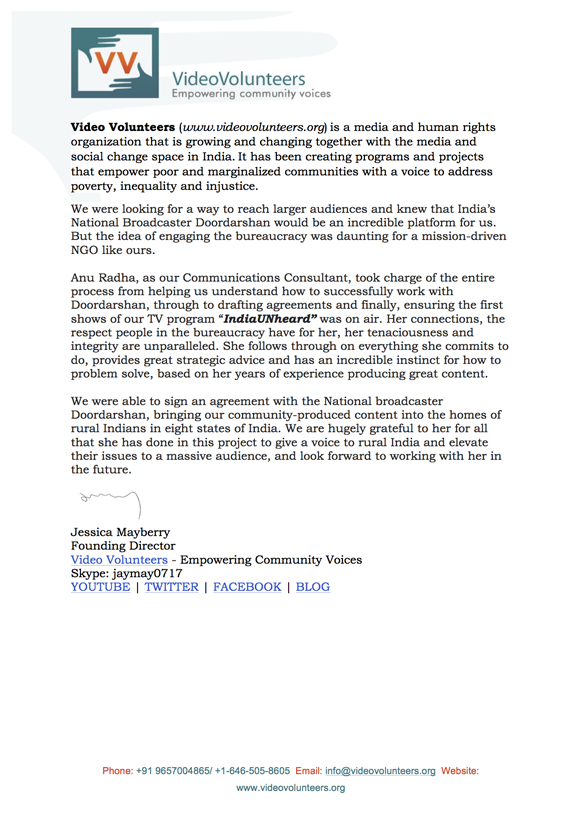
Polish Institute
 Polish Institute is an extension of the Polish diplomatic mission to India that expresses itself through contemporary projects built through cooperation with India’s leading talents and institutions, in order to contribute relevant programming within the cultural sector.
Polish Institute is an extension of the Polish diplomatic mission to India that expresses itself through contemporary projects built through cooperation with India’s leading talents and institutions, in order to contribute relevant programming within the cultural sector.
AAKAAR collaborated with Polish Institute (New Delhi) on projects related to films, script development, including a website projecting long standing historical relationship for on-going dialogue and exchange between both countries.
Embassy of the Republic of Poland in India
 Celebrating 100 years of Poland regaining independence
Celebrating 100 years of Poland regaining independence
On 30th September in Jamnagar and Balachadi, the Embassy of the Republic of Poland in New Delhi organized a ceremony to celebrate the century of Poland regaining independence by commemorating Indo-Polish relationship from ‘Generation to Generations’.
The ceremony was held with the participation, as special guests, of Poles from India, or Survivors who as children were given shelter during II World War.
The event was celebrated to commemorate the special Polish-Indian bond created by the noble act of goodwill by the Maharaja of Nawanagar (presently Jamnagar), Jam Saheb DigvijaySinhji who provided refuge to around 1000 Polish children orphaned during the course of the Second World War. Jam Saheb arranged for their stay in camps in Balachadi and Valivade, where they were not only given shelter and food but education and an environment to keep their Polish culture and traditions alive.
And now eight of Survivors arrived to Jamnagar to revisit places which are important for Polish-Indian friendship. Among them there were: Andrzej Chendynski, Wieslaw Stypula, Jadwiga Tomaszek, Jerzy Tomaszek, Zbigniew Bartosz, Roman Gutowski, Iwona Swietochwoska and Josephine Nowicka Salva.
The ceremony was attended by Ambassador of Poland to India, Adam Burakowski and many local authorities, including Hon’ minister Shri Bhupendrasinhji Manubha Chudasama.
The ceremony was co-organized with Anu Radha, a film producer and author of a movie
“A Little Poland in India” which captures the story about Polish Survivors.
1956 – A Real Life story
1956 – A Real Life story speaks of courage of a unique Indian diplomat Mohamed Ataur Rahman, the Charge d’Affaires of the Indian Embassy in Budapest in 1956, who intervened with the Soviet Union to save the life of Dr. Arpad Goncz, who subsequently served as President of Hungary from 1990 to 2000
Produced by Hungarian Cultural Institute, New Delhi with Embassy of Hungary in India, the film formed a part of commemorating the anniversary of the Hungarian Revolution, also known as the Hungarian Uprising of 1956.




